New Jersey, located in the northeastern region of the United States, boasts a diverse array of avian species throughout the year. However, a remarkable transformation occurs as winter graces the state with its icy touch.
The cold winds and frosted landscapes welcome a unique assortment of winter birds to New Jersey. These hardy feathered creatures brave the harsh conditions, offering a captivating spectacle for birdwatchers and nature enthusiasts.
From the enchanting beauty of the snowy owl to the melodic songs of the dark-eyed junco, the winter birds in New Jersey showcase nature’s ability to adapt and survive in the most challenging of environments.
Join us as we embark on a journey to discover the remarkable and resilient winter birds that call New Jersey their temporary home.
49 Winter Birds In New Jersey
New Jersey is home to various winter birds that can be observed during the colder months. While there are many more bird species in the state, here are 49 winter birds you might encounter in New Jersey:
1. House Finch
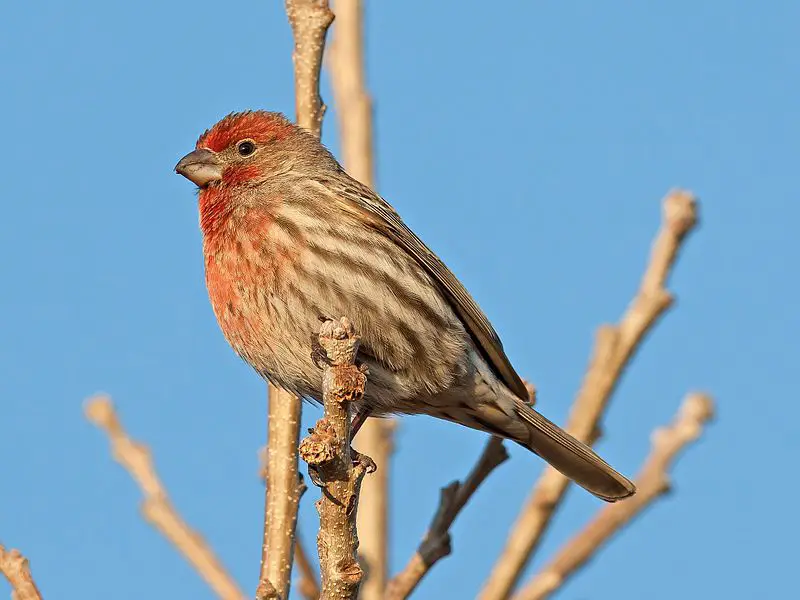
The House Finch is a small bird that is both colourful and widespread across North America. Males are easily recognized by their bright red or orange breasts and brown wings, while females and juveniles display a more subdued, brown-streaked appearance.
Originally native to the western U.S. and Mexico, they were introduced to the eastern parts of the continent in the 1940s.
These adaptable birds have thrived in urban and suburban settings, often found around buildings, in parks, and at backyard feeders, where they feed on a diet mainly consisting of seeds and grains.
Their cheerful and melodious song adds a vibrant soundtrack to their habitats, making them a favourite among bird watchers.
| Kingdom | Animalia |
| Phylum | Chordata |
| Clade | Dinosauria |
| Class | Aves |
| Order | Passeriformes |
| Family | Fringillidae |
| Genus | Haemorhous |
| Species | H. mexicanus |
2. American Goldfinch

| Kingdom | Animalia |
| Phylum | Chordata |
| Clade | Dinosauria |
| Class | Aves |
| Order | Passeriformes |
| Family | Fringillidae |
| Genus | Spinus |
| Species | S. tristis |
3. Dark-Eyed Junco
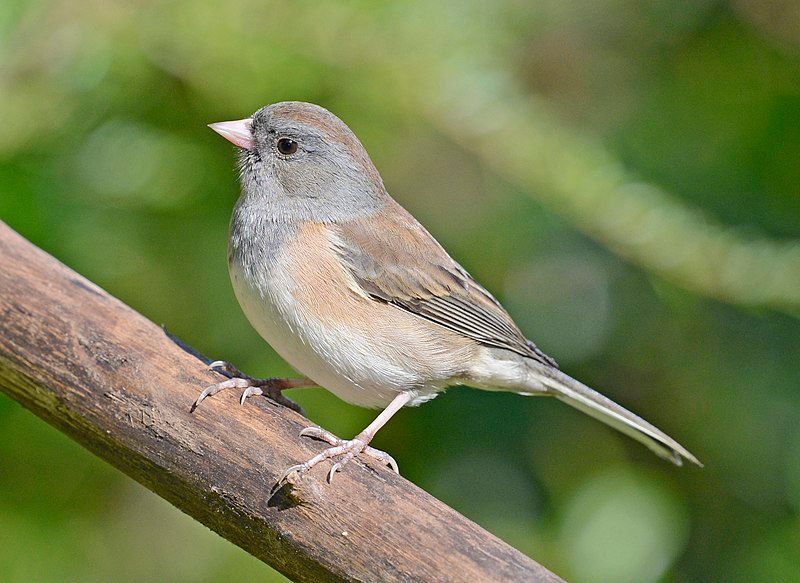
The Dark-Eyed Junco is common across North America, especially in winter. These small, sparrow-sized birds exhibit a striking contrast in coloration, with their dark gray or black upper bodies and white bellies.
Often referred to as “snowbirds,” they are known for appearing in backyards and forest floors right before the winter season sets in. Juncos are ground feeders, primarily dining on seeds and insects.
They have a soft, musical trill that adds to the winter landscape’s ambiance. Their habitat is versatile, ranging from forests to suburban areas, making them one of the most widespread and familiar backyard birds.
| Kingdom | Animalia |
| Phylum | Chordata |
| Clade | Dinosauria |
| Class | Aves |
| Order | Passeriformes |
| Family | Passerellidae |
| Genus | Junco |
| Species | J. hyemalis |
4. Northern Cardinal
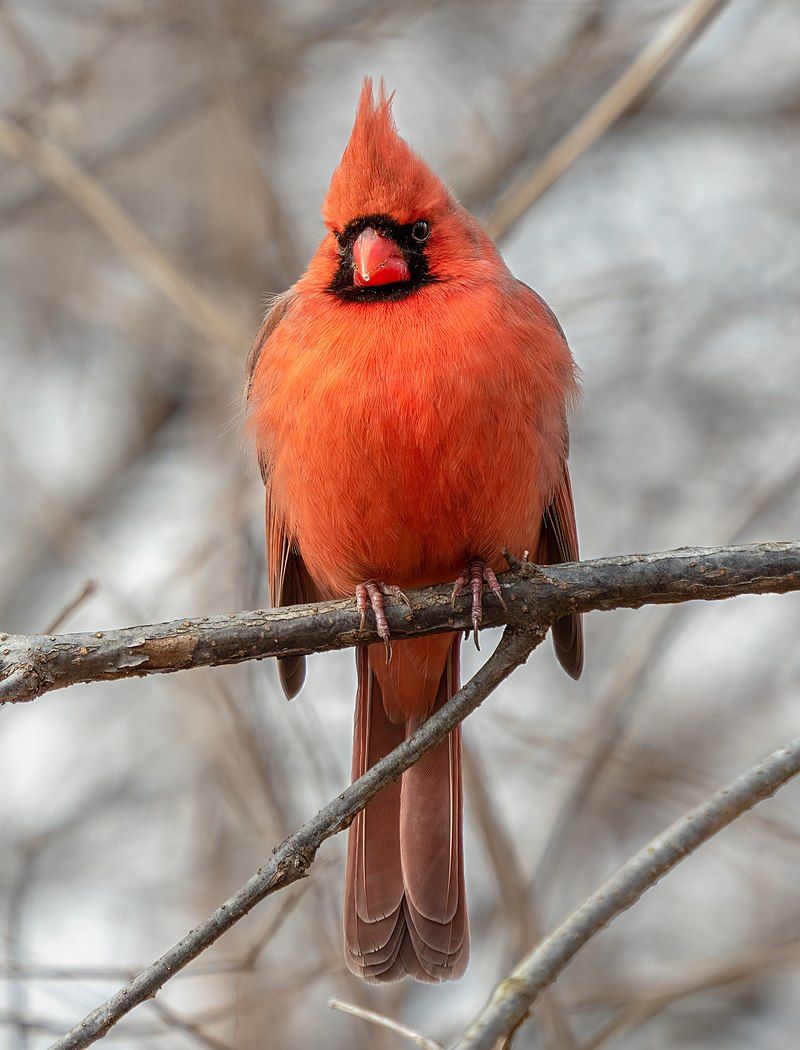
The Northern Cardinal is one of the most recognizable and beloved backyard birds, famed for the male’s vibrant red plumage and the female’s more subdued, but still striking, shades of brown and red accents.
These birds are year-round residents of their range, which spans the eastern United States, extending south into Mexico and Central America. Cardinals are known for their clear, melodious songs and calls, which can be heard at any time of the year.
They exhibit strong pair bonds, often seen feeding seeds to each other in a tender display of affection. Cardinals prefer habitats with thick shrubbery and are frequent visitors to bird feeders, bringing a splash of colour to their surroundings, especially in winter.
| Kingdom | Animalia |
| Phylum | Chordata |
| Clade | Dinosauria |
| Class | Aves |
| Order | Passeriformes |
| Family | Cardinalidae |
| Genus | Cardinalis |
| Species | C. cardinalis |
5. Tufted Titmouse
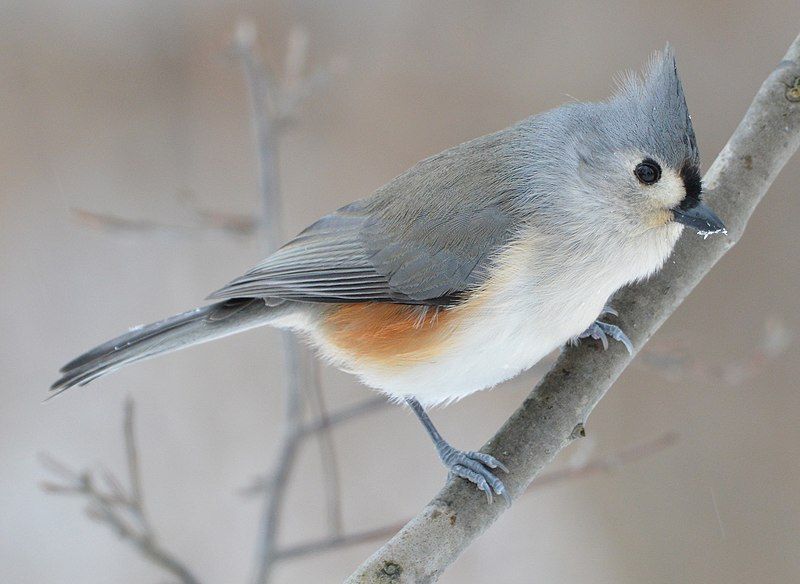
The Tufted Titmouse is a small, charismatic bird with a grey upper body, white underparts, and a distinctive tuft of feathers on its head.
Found throughout the eastern United States, these birds are a common sight at bird feeders, where they enjoy a diet of seeds, nuts, and insects.
The Tufted Titmouse is known for its curious and bold nature, often investigating humans and their belongings.
Their song is a clear, whistling series of notes, which adds vibrancy to their woodland habitat. They nest in tree holes and, interestingly, often line their nests with soft materials, including hair from animals or humans.
| Kingdom | Animalia |
| Phylum | Chordata |
| Clade | Dinosauria |
| Class | Aves |
| Order | Passeriformes |
| Family | Paridae |
| Genus | Baeolophus |
| Species | B. bicolor |
6. White-Breasted Nuthatch

The White-Breasted Nuthatch is a small, agile bird, easily recognized by its white underparts, blue-grey upper parts, and black cap. It is known for its unique behaviour of walking headfirst down tree trunks, searching for insects hidden in the bark.
This bird has a loud, nasal call and is often found in deciduous forests across North America. White-Breasted Nuthatches are year-round residents in their range, rarely migrating.
They stash seeds and nuts in tree crevices to eat later, showing remarkable memory for their hidden food stores. Their presence delights bird watchers, adding life and movement to the forest landscape.
| Kingdom | Animalia |
| Phylum | Chordata |
| Clade | Dinosauria |
| Class | Aves |
| Order | Passeriformes |
| Family | Sittidae |
| Genus | Sitta |
| Species | S. carolinensis |
7. Blue Jay
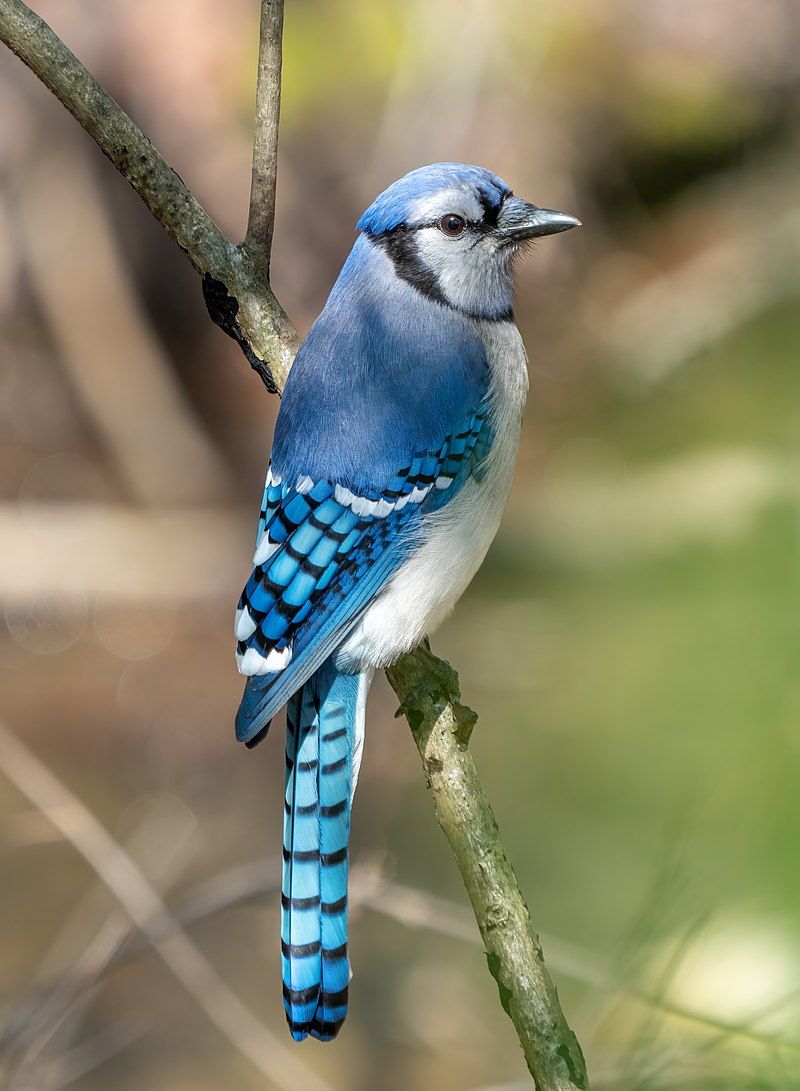
| Kingdom | Animalia |
| Phylum | Chordata |
| Clade | Dinosauria |
| Class | Aves |
| Order | Passeriformes |
| Family | Corvidae |
| Genus | Cyanocitta |
| Species | C. cristata |
8. White-Throated Sparrow
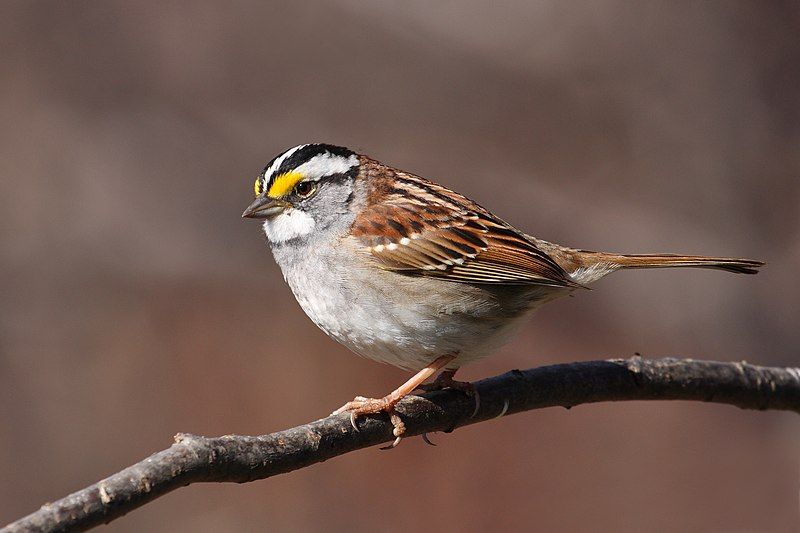
The white-throated sparrow is a type of bird that belongs to the passerine family called Passerellidae. This family of birds is commonly known as New World sparrows. Passerines are a diverse group of birds that make up more than half of all bird species.
They are known for their unique ability to perch and grip onto branches with their feet. The white-throated sparrow is easily distinguished by the white patch on its throat. This feature gives the bird its name.
These sparrows are native to North America and can be found throughout the continent, from Canada to Mexico. They are migratory birds, meaning they travel long distances during certain times of the year.
During the breeding season, white-throated sparrows are known for their distinct song, which can be described as a whistling “Oh sweet Canada, Canada, Canada.” This song helps them attract mates and establish their territory.
White-throated sparrows are relatively small birds, measuring about 6 to 7 inches long. They have a plump body with a rounded head and a short tail. Their plumage consists of a combination of grey, brown, and black feathers.
| Kingdom | Animalia |
| Phylum | Chordata |
| Clade | Dinosauria |
| Class | Aves |
| Order | Passeriformes |
| Family | Passerellidae |
| Genus | Zonotrichia |
| Species | Z. albicollis |
9. Carolina Wren
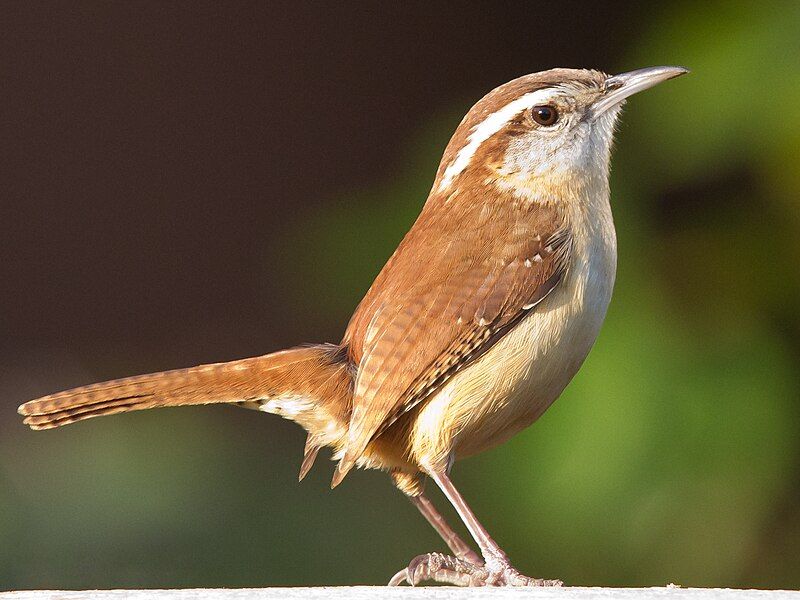
The Carolina wren is a type of wren bird that can be found in several regions. It is considered a common species, meaning it is frequently seen in these areas. The bird is mainly found in the eastern half of the United States of America.
This includes states like North Carolina, South Carolina, and Virginia. However, it can also be spotted in other states within this region. Apart from the United States, the Carolina wren is also seen in certain parts of Canada.
Specifically, it can be found in the extreme south of Ontario. This means that it is only present in the southernmost part of the province.
This is interesting because the bird’s range extends beyond the borders of the United States. Additionally, the Carolina wren can be observed in the extreme northeast of Mexico.
This means that it is found in the northeastern part of the country, close to the border it shares with the United States.
This further highlights the bird’s ability to inhabit different regions within North America. The Carolina wren is a resident bird in the eastern half of the United States, the extreme south of Ontario, Canada, and the extreme northeast of Mexico.
It is a common species, often seen in these areas. Its range includes several states.
| Kingdom | Animalia |
| Phylum | Chordata |
| Clade | Dinosauria |
| Class | Aves |
| Order | Passeriformes |
| Family | Troglodytidae |
| Genus | Thryothorus |
| Species | T. ludovicianus |
10. Northern Flicker
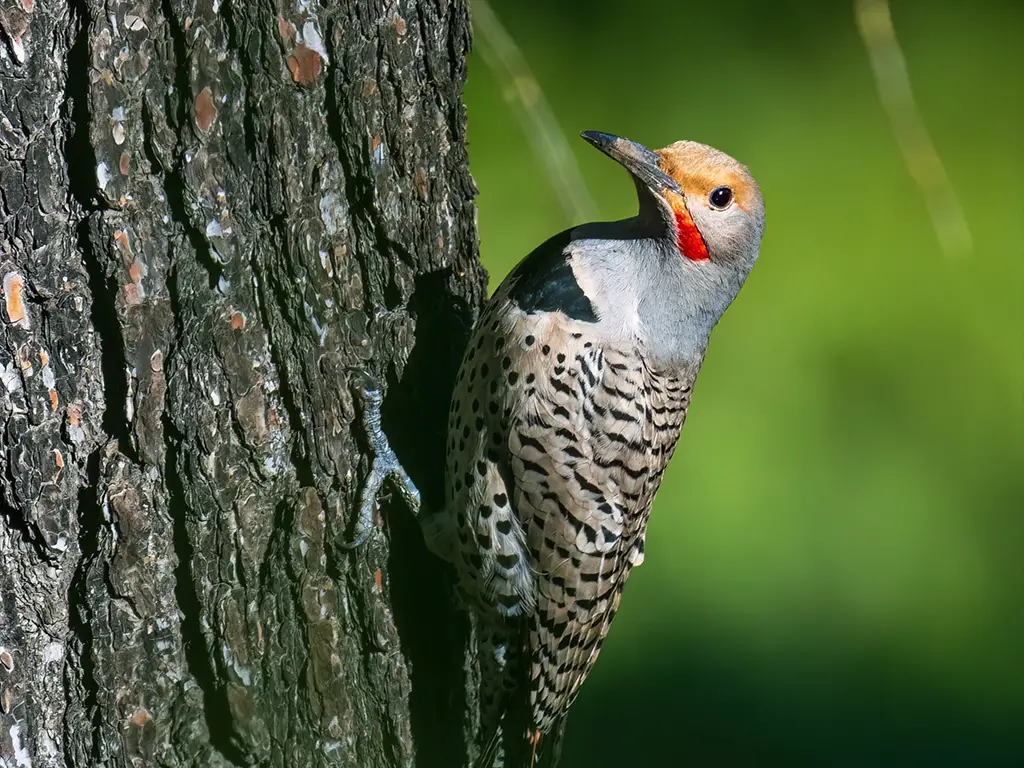
The northern flicker is a type of bird that belongs to the woodpecker family. It is not a very large bird but also not too small. The northern flicker can be found in many parts of North America.
It is also native to some areas in Central America, such as Cuba and the Cayman Islands. One interesting thing about the northern flicker is that it is one of the few woodpecker species that migrate.
Migration means that these birds travel from one place to another during different seasons. They do this to find food and suitable habitats.
The northern flicker migrates to different regions depending on the time of year. During the breeding season, which is usually in the spring or summer, the northern flicker can be found in many parts of North America.
They build their nests in trees and use their strong beaks to create holes in the wood. These holes are called cavities and serve as their homes. Northern flickers are known for their distinctive markings.
They have a brown body with black spots, and their wings have a white patch easily visible when flying. Another unique feature is the red or yellow colouration on the underside of their wings and tail.
| Kingdom | Animalia |
| Phylum | Chordata |
| Clade | Dinosauria |
| Class | Aves |
| Order | Piciformes |
| Family | Picidae |
| Genus | Colaptes |
| Species | C. auratus |
11. Wrens
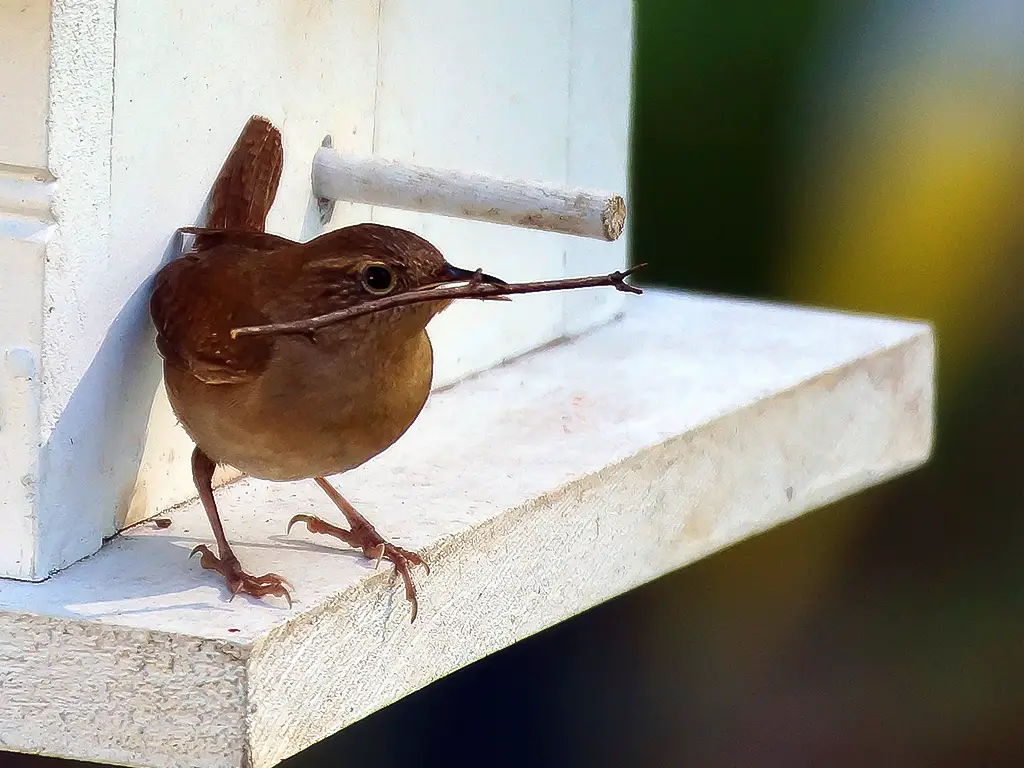
Wrens are a type of bird that belongs to the family Troglodytidae. They are mainly found in the New World, which includes the Americas.
There are about 88 different species of wrens, and they are categorized into 19 different genera, which is a higher taxonomic rank. Interestingly, there is only one species of wren, called the Eurasian wren, that can be found in the Old World.
The Old World refers to regions such as Europe, Asia, and Africa. In English-speaking countries, this particular wren is called just “wren.”This is because the Eurasian wren is believed to be the original wren species that gave rise to the name.
Over time, as people encountered different species of wrens in the New World, they started using more specific names to differentiate them.
However, the name “wren” stuck with the Eurasian species because it was discovered and named first. So, when people in Anglophone regions say “wren,” they are usually referring to the Eurasian wren.
It is essential to note that this is a regional naming convention and may not be true in other languages or parts of the world.
| Kingdom | Animalia |
| Phylum | Chordata |
| Clade | Dinosauria |
| Class | Aves |
| Order | Passeriformes |
| Family | Troglodytidae |
12. Black-Capped Chickadee
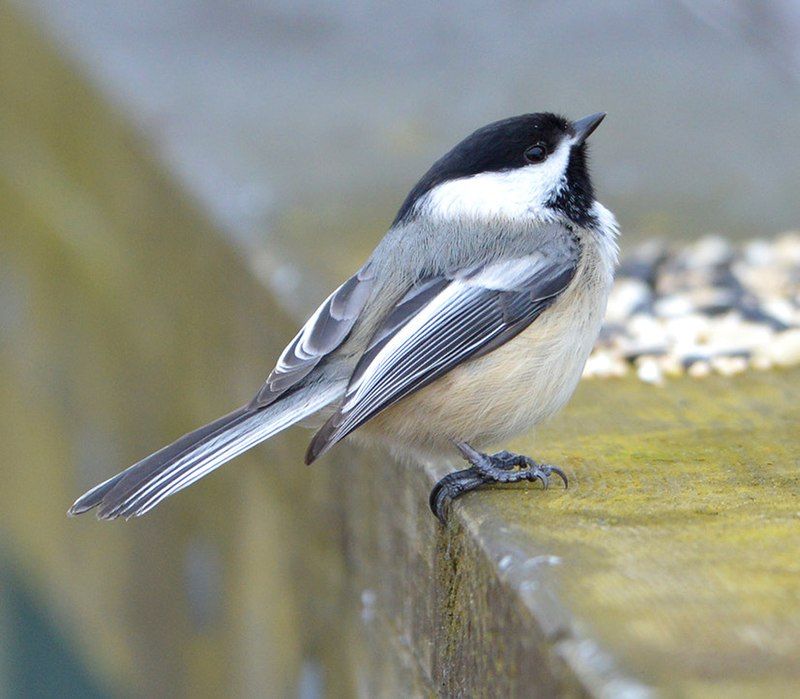
The black-capped chickadee is a small songbird that can be found in North America. It is known for its distinctive black cap and white cheeks.
This bird is not migratory, meaning it does not travel long distances during different seasons. The black-capped chickadee prefers to live in deciduous and mixed forests.
These types of forests provide the bird with the necessary habitat, such as trees and shrubs, where it builds its nests and finds food.
As a passerine bird, it belongs to the tit family, which is scientifically called Paridae. Interestingly, the black-capped chickadee holds special significance in certain regions.
It is the state bird of Massachusetts and Maine in the United States, symbolizing its importance to the local environment and culture.
Additionally, in Canada, specifically in the province of New Brunswick, it is recognized as the provincial bird. Overall, the black-capped chickadee is a small, nonmigratory songbird that can be found in North America.
It thrives in deciduous and mixed forests and belongs to the tit family. Its significance is acknowledged through its designation as the state bird in Massachusetts and Maine, as well as the provincial bird of New Brunswick.
| Kingdom | Animalia |
| Phylum | Chordata |
| Clade | Dinosauria |
| Class | Aves |
| Order | Passeriformes |
| Family | Paridae |
| Genus | Poecile |
| Species | P. atricapillus |
13. Old World Sparrows
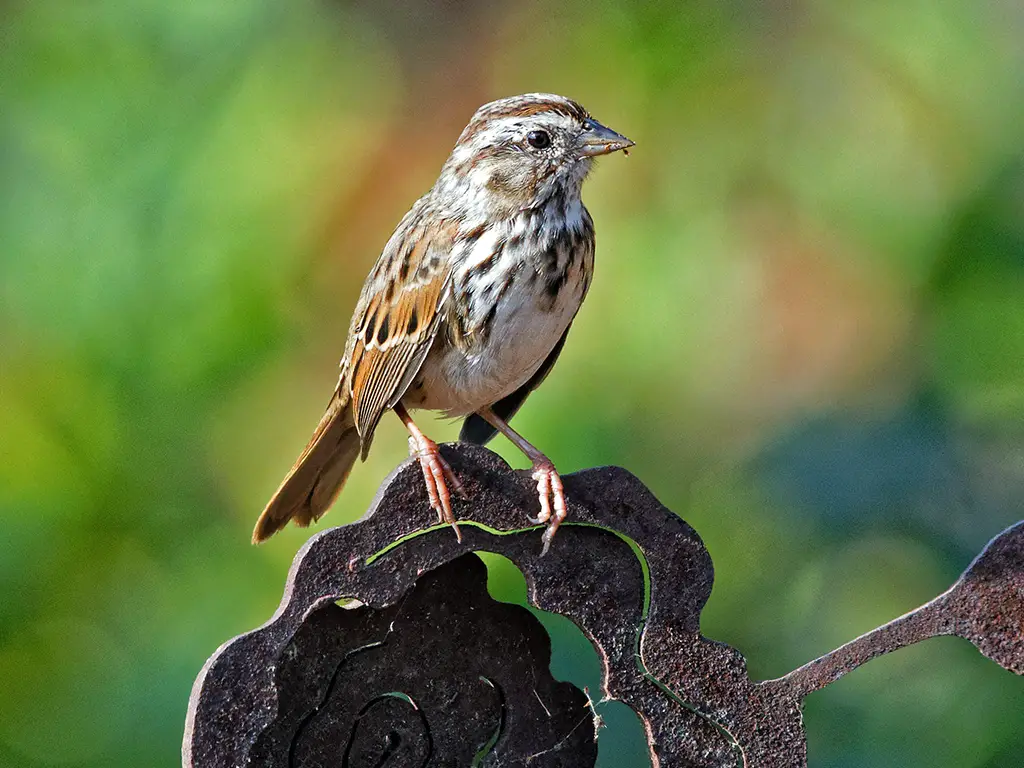
Old World sparrows belong to the family Passeridae, which is a group of small passerine birds. These birds are commonly referred to as true sparrows.
However, it is important to note that the term “true sparrows” is also used specifically for a particular genus within the Passeridae family, called Passer. Passeridae is a family of birds that includes various species of sparrows.
These birds are found primarily in the Old World, which refers to the continents of Europe, Asia, and Africa.
They are well-known for their small size and characteristic features such as short, stout bills and rounded wings. The term “Old World sparrows” distinguishes these birds from their New World counterparts, including the Americas.
While there are some similarities between the two groups, Old World sparrows have distinct characteristics that set them apart. Old World sparrows are known for their adaptability and ability to thrive in various environments.
They can be found in various habitats, including grasslands, forests, urban areas, and agricultural landscapes.
These birds have successfully adapted to human-altered environments, often nesting in buildings and feeding on human-provided food sources. The genus Passer is a specific.
| Kingdom | Animalia |
| Phylum | Chordata |
| Clade | Dinosauria |
| Class | Aves |
| Order | Passeriformes |
| Family | Passeridae |
14. Red-Breasted Nuthatch
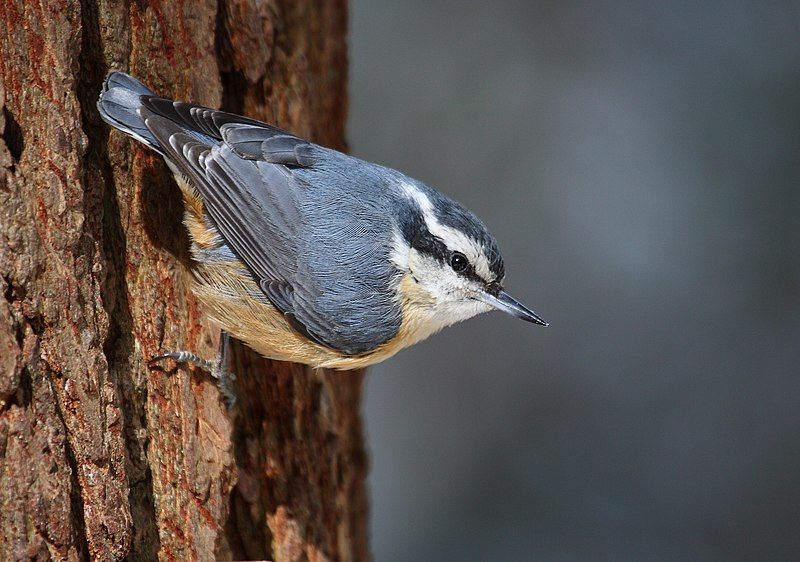
The red-breasted nuthatch is a small bird that is known for its beautiful appearance and unique characteristics. It has blue-grey feathers on its upper body and cinnamon-coloured feathers on its underparts.
This combination of colours creates a striking contrast. Looking closely at the red-breasted nuthatch, you will notice a white throat and face. These white areas provide a stark contrast against the rest of its body.
Additionally, a distinct black stripe runs through its eyes, giving it a charming and distinctive look. Another notable feature of the red-breasted nuthatch is its straight grey bill.
This bill is perfectly shaped for its feeding habits and allows it to crack open seeds and nuts easily. The bird’s bill is functional and adds to its overall appearance. One of the most striking features of the red-breasted nuthatch is its black crown.
This black area on top of its head gives the bird a regal and elegant look. When combined with its blue-grey and cinnamon colours, the black crown adds a touch of sophistication to its appearance. Apart from its visual characteristics, the red-breasted nuthatch has a unique call.
Described as a tin trumpet, its call is high-pitched.
| Kingdom | Animalia |
| Phylum | Chordata |
| Clade | Dinosauria |
| Class | Aves |
| Order | Passeriformes |
| Family | Sittidae |
| Genus | Sitta |
| Species | S. canadensis |
15. New World Sparrow
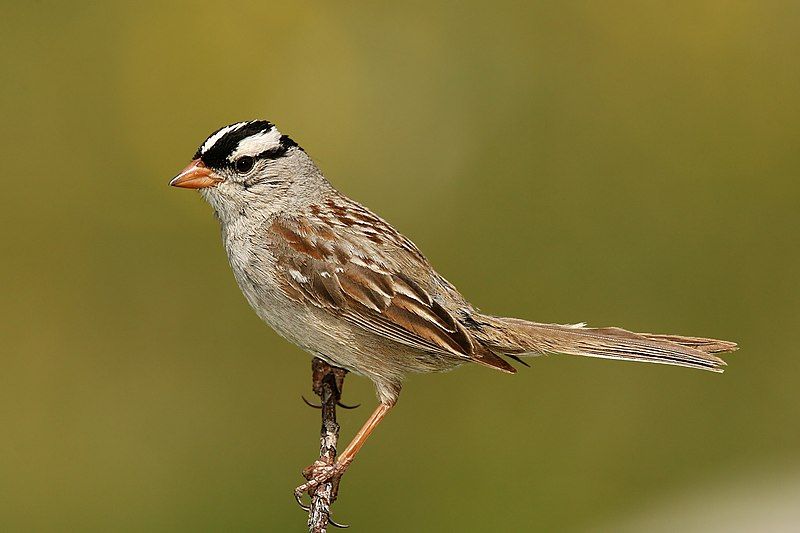
New World sparrows are a diverse group of birds found primarily in the New World. They belong to the family Passerellidae, which comprises various species. These sparrows are known for their diet, primarily consisting of seeds.
They have conical bills that are well-adapted for cracking open and consuming seeds. In terms of appearance, New World sparrows are typically brown or grey in colour.
This colouring helps them blend in with their natural environment, providing camouflage and protection from predators.
The muted tones of their feathers also allow them to be less noticeable to potential threats. One interesting feature of many New World sparrows is their distinctive head patterns.
Each species within this group may have its own unique markings, such as stripes, spots, or patches of different colours. These head patterns serve multiple purposes. They can be used for species recognition, helping sparrows identify and communicate with their own kind.
These patterns can also play a role in attracting mates during the breeding season. New World sparrows are found in various habitats throughout the Americas.
They can be seen in various environments, including forests, grasslands, shrublands, and even urban areas. This adaptability allows them to thrive and take advantage of diverse ecosystems.
| Kingdom | Animalia |
| Phylum | Chordata |
| Clade | Dinosauria |
| Class | Aves |
| Order | Passeriformes |
| Family | Passerellidae |
16. House Sparrow
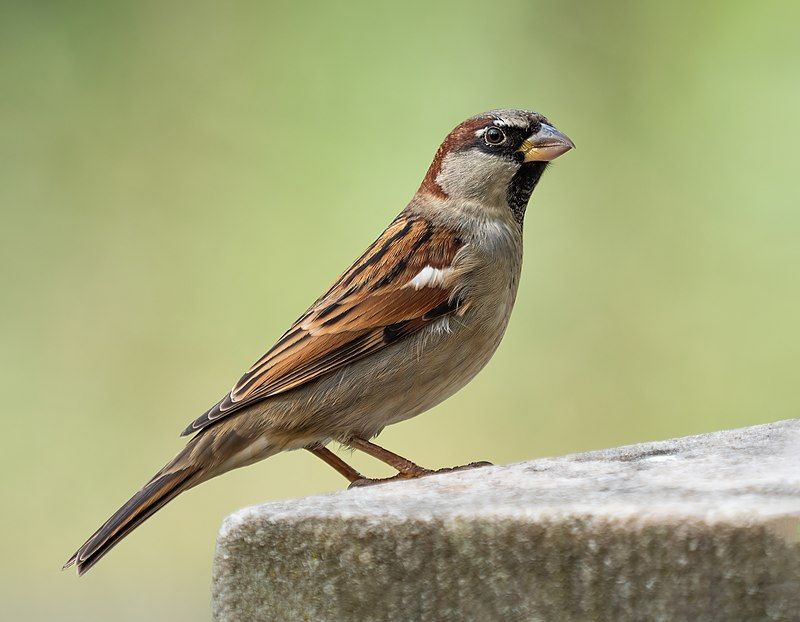
The house sparrow is a type of bird that belongs to the sparrow family called Passeridae. These birds can be found in many different parts of the world. They are quite small in size, typically measuring about 16 cm in length.
In terms of weight, they usually range between 24 to 39.5 grams. Regarding their appearance, female and young house sparrows are generally coloured in pale shades of brown and grey.
This colouration helps them blend in with their surroundings and provides them with some camouflage. On the other hand, male house sparrows have more vibrant colours.
They display black, white, and brown markings, making them easily distinguishable from the females and young birds. The contrasting colours of the male house sparrows serve various purposes. Firstly, these colours help attract mates during the breeding season.
The brighter markings act as a visual signal to the females, indicating that the male is healthy and capable of providing for offspring.
These markings also play a role in defending territory and establishing dominance among other male sparrows. The house sparrow’s colouration is not only limited to their feathers. They also have distinct beak colours that differ between males and females.
| Kingdom | Animalia |
| Phylum | Chordata |
| Clade | Dinosauria |
| Class | Aves |
| Order | Passeriformes |
| Family | Passeridae |
| Genus | Passer |
| Species | P. domesticus |
17. Downy Woodpecker
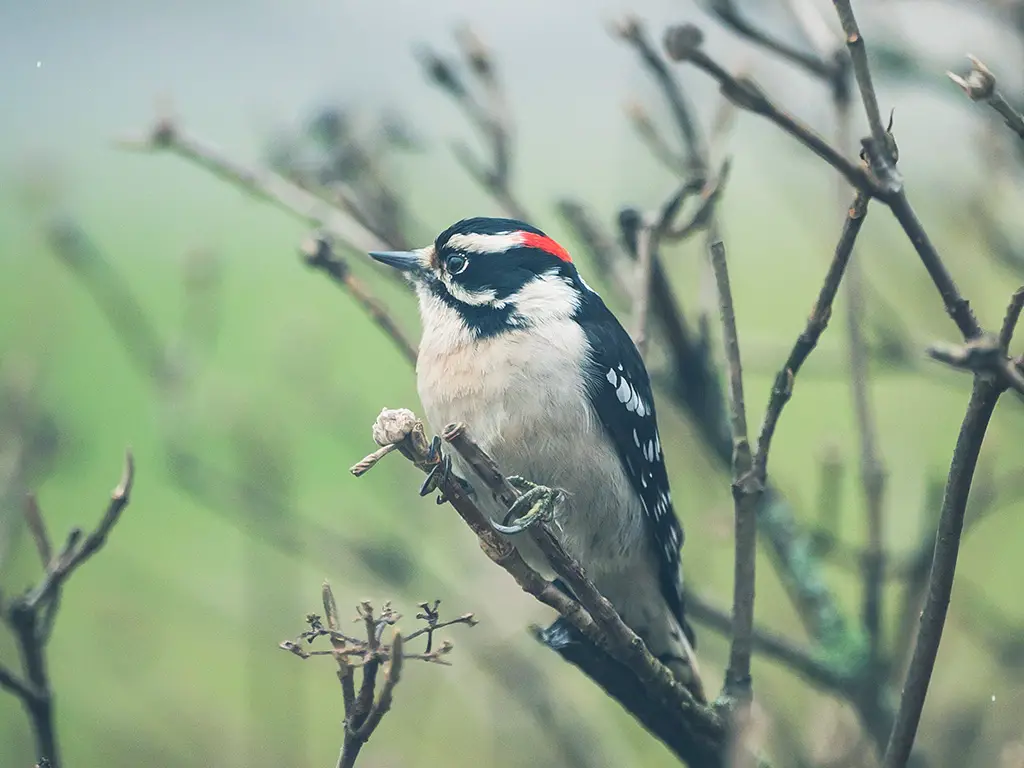
The downy woodpecker is a type of bird known as a woodpecker. It is the smallest species of woodpecker found in North America.
Its size can range from 14 to 18 centimetres. These woodpeckers can be found in various forested areas across the United States and Canada.
However, they are not commonly seen in desert regions in the southwest or in the northern tundra. Due to their small size, downy woodpeckers are well-adapted to living in forested environments.
They can navigate through the trees and search for food more easily than larger woodpecker species. One interesting feature of the downy woodpecker is its ability to drum on trees.
This drumming serves multiple purposes, including communication with other woodpeckers and marking its territory. The diet of the downy woodpecker primarily consists of insects and larvae found within the trees.
They use their strong beaks to peck at the bark and wood, uncovering their prey. These woodpeckers are known for their distinct black and white plumage.
They have a white belly and back, with black wings and a black head. This colouration helps them blend in with the tree.
| Kingdom | Animalia |
| Phylum | Chordata |
| Clade | Dinosauria |
| Class | Aves |
| Order | Piciformes |
| Family | Picidae |
| Genus | Dryobates |
| Species | D. pubescens |
18. Red-Bellied Woodpecker
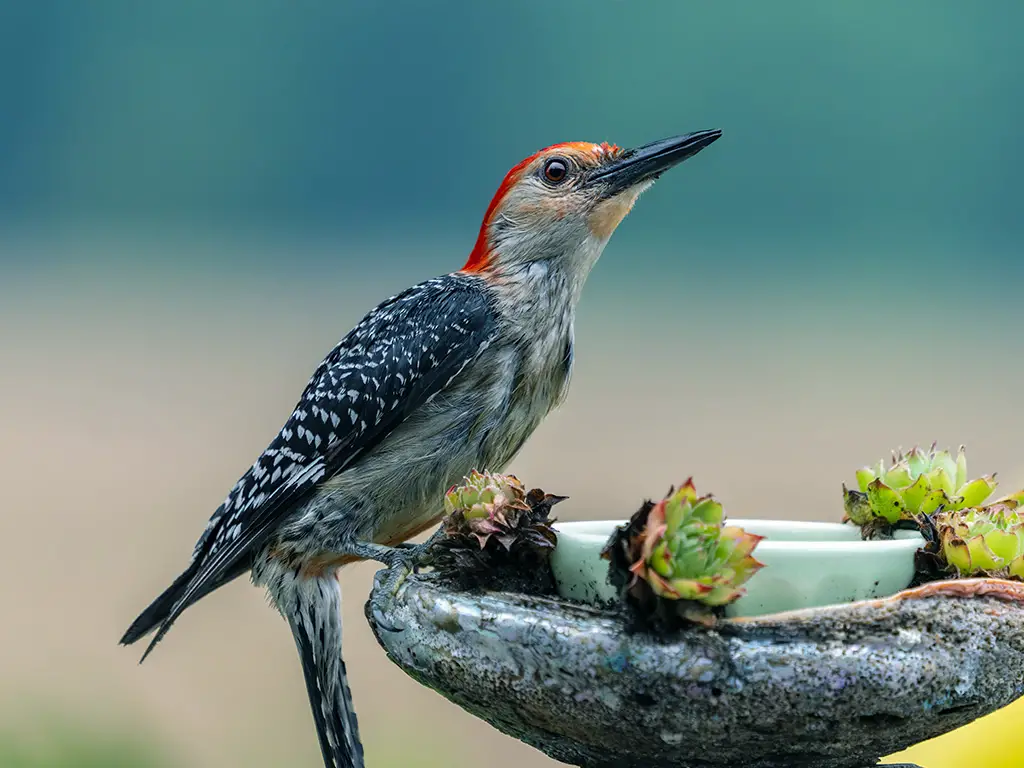
The red-bellied woodpecker is a type of bird that belongs to the family Picidae. It is not too big or too small; it is considered to be a medium-sized woodpecker.
This means that it is smaller than some other woodpecker species but larger than others. These woodpeckers are found primarily in the eastern part of the United States. However, they can also be seen in other areas.
They have a wide range, stretching from as far south as Florida to as far north as Canada. This means that they can be found in many different states and provinces within these regions. Regarding their appearance, the red-bellied woodpecker has some distinct features.
As the name suggests, they have a red belly, although this may not be immediately noticeable. Their belly is actually more of a pale or dull red colour compared to other parts of their body.
They also have a red cap on the top of their head, which is more vibrant and noticeable. In addition to their red belly and cap, these woodpeckers have a black and white pattern on their back, wings, and tail.
The black feathers provide a nice contrast against the white feathers, creating a visual.
| Kingdom | Animalia |
| Phylum | Chordata |
| Clade | Dinosauria |
| Class | Aves |
| Order | Piciformes |
| Family | Picidae |
| Genus | Melanerpes |
| Species | M. carolinus |
19. Woodpeckers
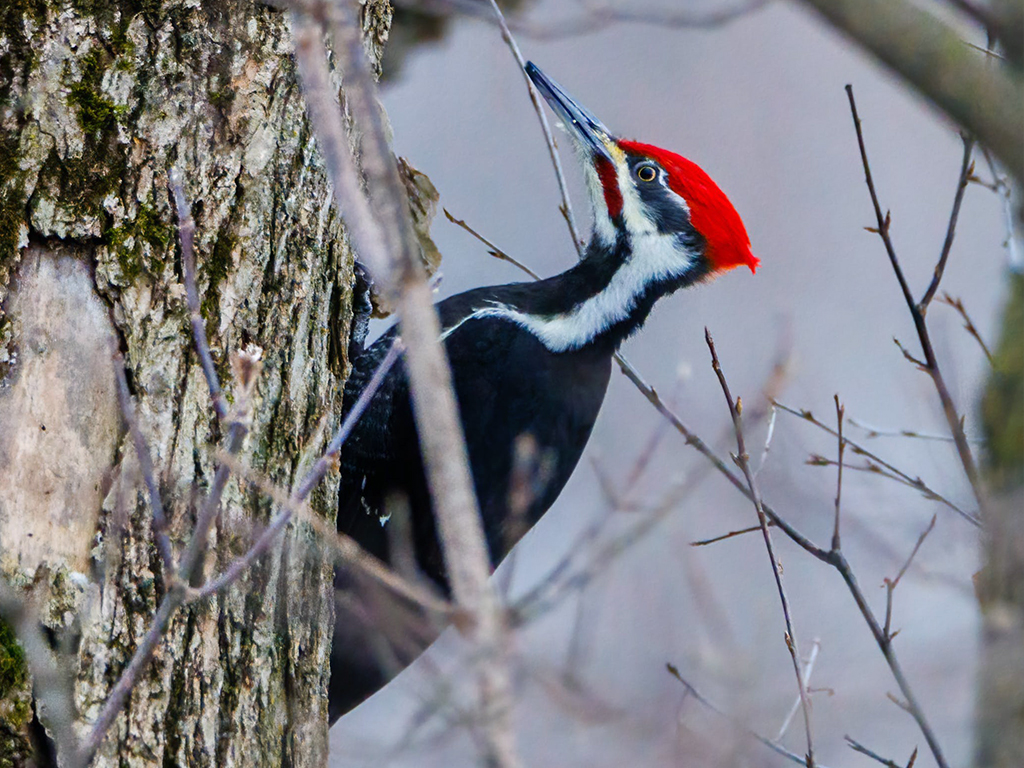
Woodpeckers belong to a bird family called Picidae. This family also includes other birds like piculets, wrynecks, and sapsuckers. Members of the Picidae family can be found all around the world, except in certain places.
Australia, New Guinea, New Zealand, Madagascar, and the extreme polar regions are the areas where these birds are not found. Woodpeckers are unique birds known for their ability to peck and drum on trees.
They have specially adapted beaks and strong neck muscles that allow them to strike trees repeatedly. This behavior is used for feeding, communication, and establishing territories. Piculets are smaller woodpecker-like birds that belong to the Picidae family.
They have similar physical characteristics and behaviours as woodpeckers, but they are usually smaller in size. Wrynecks, another member of the Picidae family, are small, insect-eating birds with long, slender bills.
They are known for their ability to twist their necks in a snake-like fashion. Sapsuckers, also part of the Picidae family, are woodpeckers with unique feeding habits. They drill small holes in trees.
| Kingdom | Animalia |
| Phylum | Chordata |
| Clade | Dinosauria |
| Class | Aves |
| Order | Piciformes |
| Family | Picidae |
20. Mourning Dove
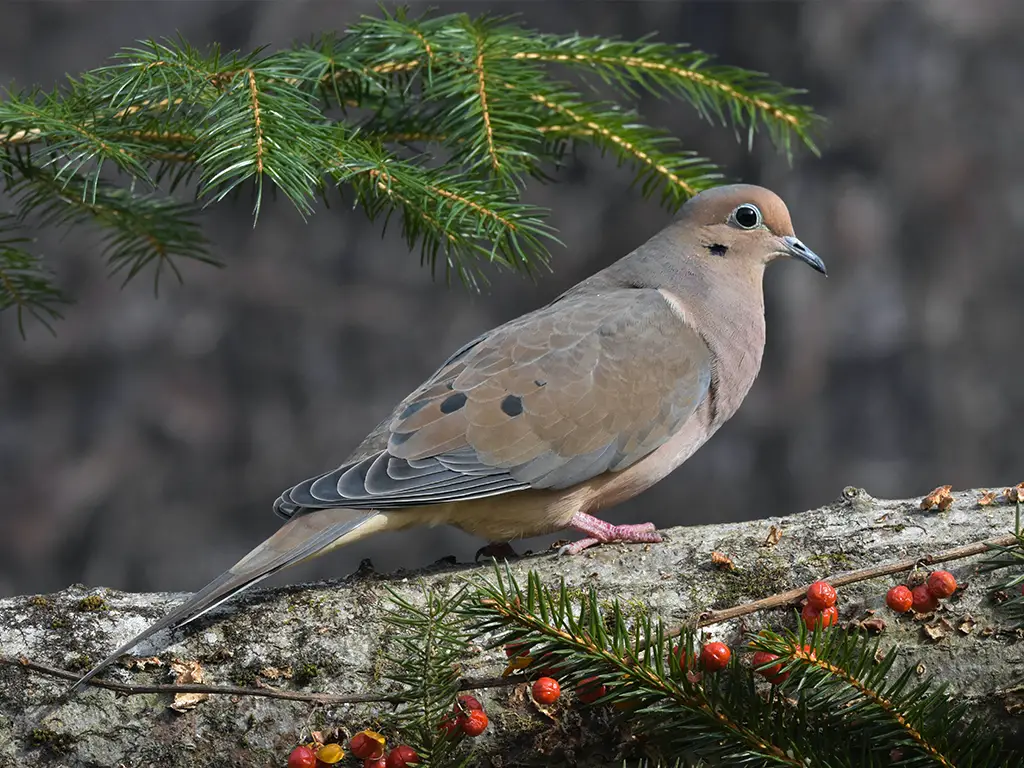
The mourning dove is a type of bird that belongs to the dove family called Columbidae. This bird is also known by different names, such as the American mourning dove, the rain dove, colloquially, the turtle dove.
In the past, it was referred to as the Carolina pigeon and Carolina turtledove. The mourning dove is a common species found in North and Central America. It is recognized for its soft, mournful cooing sound, which gives it its name.
This bird is known for its slender body and long, pointed tail. It has a greyish-brown colour with lighter shades on its underparts. One interesting fact about mourning doves is their ability to adapt to various habitats.
They can be found in different environments like forests, fields, urban areas, and even deserts. They are known to thrive in both rural and suburban settings. Mourning doves primarily feed on seeds, grains, and fruits.
They have a unique diet as they can swallow seeds whole and store them in their crop, a specialized part of their digestive system. This allows them to eat in one location and then retreat to a safer place to digest their food. These birds are monogamous, meaning they mate.
| Kingdom | Animalia |
| Phylum | Chordata |
| Clade | Dinosauria |
| Class | Aves |
| Order | Columbiformes |
| Family | Columbidae |
| Genus | Zenaida |
| Species | Z. macroura |
21. Song Sparrow
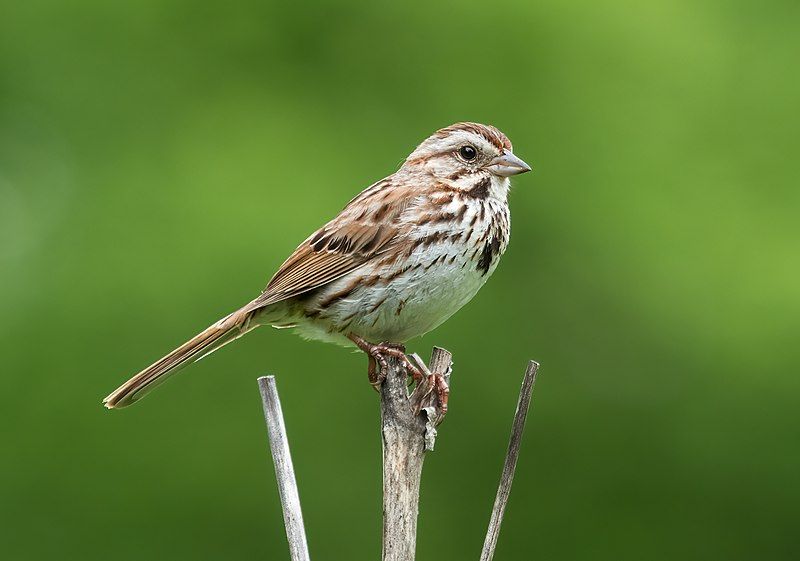
The song sparrow is a type of sparrow that can be found in North America. It is considered to be medium-sized in comparison to other sparrows.
Out of all the sparrows native to North America, the song sparrow is known to be one of the most abundant species.
This means that there are a large number of song sparrows in the wild. Not only is the song sparrow abundant, but it is also quite variable.
This means that there can be different variations or types of song sparrows. They may have slight differences in appearance or behaviour.
In addition to being abundant and variable, the song sparrow is also adaptable. This means that it can adjust well to different environments and conditions. It is able to thrive in various habitats, such as grasslands, marshes, and even urban areas.
The adaptability of the song sparrow allows it to have a wide range of distribution. It can be found in many parts of North America, from Canada down to Mexico.
The song sparrow is a fascinating, medium-sized, abundant, variable, and adaptable bird.
Its ability to adapt to different environments has contributed to its success as a species in North America.
| Kingdom | Animalia |
| Phylum | Chordata |
| Clade | Dinosauria |
| Class | Aves |
| Order | Passeriformes |
| Family | Passerellidae |
| Genus | Melospiza |
| Species | M. melodia |
22. Cardinalidae

Cardinalidae is a family of birds that are found only in the New World. This means that they are native to the Americas and are not found anywhere else in the world. The family comprises different species, including cardinals, grosbeaks, and buntings.
These birds are all part of the same family because they share similar characteristics and traits. Cardinals are perhaps the most well-known members of the Cardinalidae family.
They are known for their vibrant red plumage, which is more prominent in the males than in the females.
Cardinals often feed on seeds and insects in backyards and gardens. They have a distinct crest on their heads, which adds to their unique appearance. Grosbeaks are another type of bird that belongs to the Cardinalidae family.
They are named after their large, thick beaks, which are adapted for cracking open seeds and nuts. Grosbeaks come in various colours, including red, black, and yellow.
They are known for their beautiful songs and can be found in forests and woodlands across the Americas. Buntings are also part of the Cardinalidae family. They are small to medium-sized birds that are known for their colourful plumage.
| Kingdom | Animalia |
| Phylum | Chordata |
| Clade | Dinosauria |
| Class | Aves |
| Order | Passeriformes |
| Family | Cardinalidae |
23. American Robin
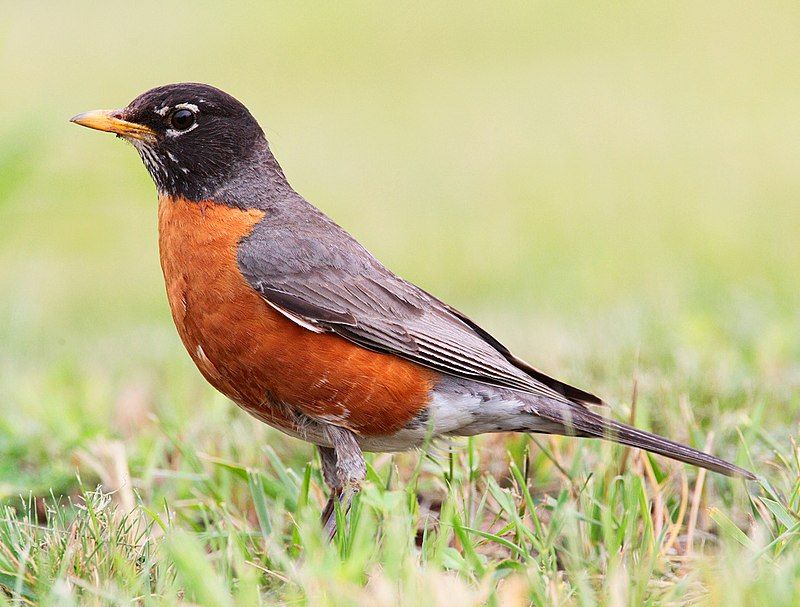
The American robin is a type of bird that migrates. It belongs to the true thrush genus and the Turdidae family, a larger thrush family. It gets its name from the European robin because of its reddish-orange breast.
However, it is important to note that the American and European robin are not closely related. The European robin is a different species and belongs to the Old World flycatcher family.
Despite their similar names and physical characteristics, these two birds are not closely related regarding their genetic makeup.
They may share some similarities in appearance, such as the reddish-orange breast, but their evolutionary paths have taken them in different directions.
The American robin is primarily found in North America, while the European robin is native to Europe and parts of Asia.
Both species have adapted to their respective environments and habitats over time.
The American robin is known for its ability to migrate long distances, often travelling south during winter and returning north for the breeding season. Regarding physical characteristics, the American robin is larger than the European robin.
It has a greyish-brown back and a distinct reddish-orange breast, which is a defining feature of the species.
| Kingdom | Animalia |
| Phylum | Chordata |
| Clade | Dinosauria |
| Class | Aves |
| Order | Passeriformes |
| Family | Turdidae |
| Genus | Turdus |
| Species | T. migratorius |
24. American Crow
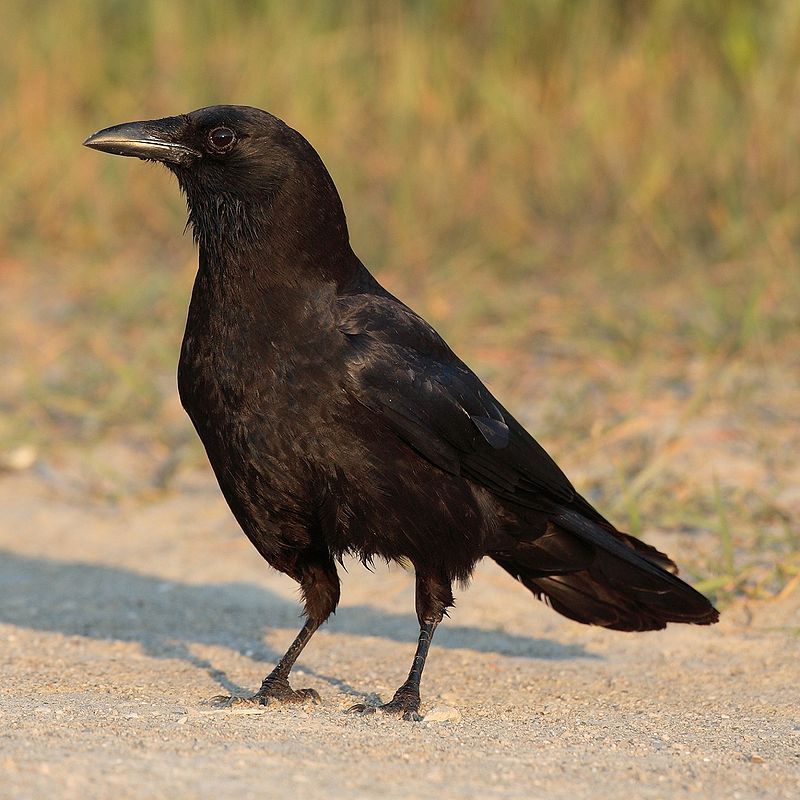
The American crow is a type of bird that belongs to the Corvidae family. This family includes other birds like ravens and jays. The American crow is quite big and is known as a passerine bird, meaning it has feet adapted for perching on branches.
You can find American crows in many parts of North America. They are a very common bird so that you might have seen them in your neighbourhood. They have adapted well to different environments and can be found in urban areas, forests, and even open fields.
Interestingly, American crows are similar to two other types of crows found in different parts of the world. These are the carrion crow and the hooded crow found in Europe and Asia.
Despite being from different continents, these three crows occupy the same ecological niche. An ecological niche refers to the role a species plays in its environment. In this case, the American crow, carrion crow, and hooded crow all have similar behaviours and habits.
They are opportunistic feeders, meaning they eat a wide range of things like insects, fruits, small animals, and even garbage. They also play important roles in controlling populations of certain pests and scavenging.
| Kingdom | Animalia |
| Phylum | Chordata |
| Clade | Dinosauria |
| Class | Aves |
| Order | Passeriformes |
| Family | Corvidae |
| Genus | Corvus |
| Species | C. brachyrhynchos |
25. Common Starling
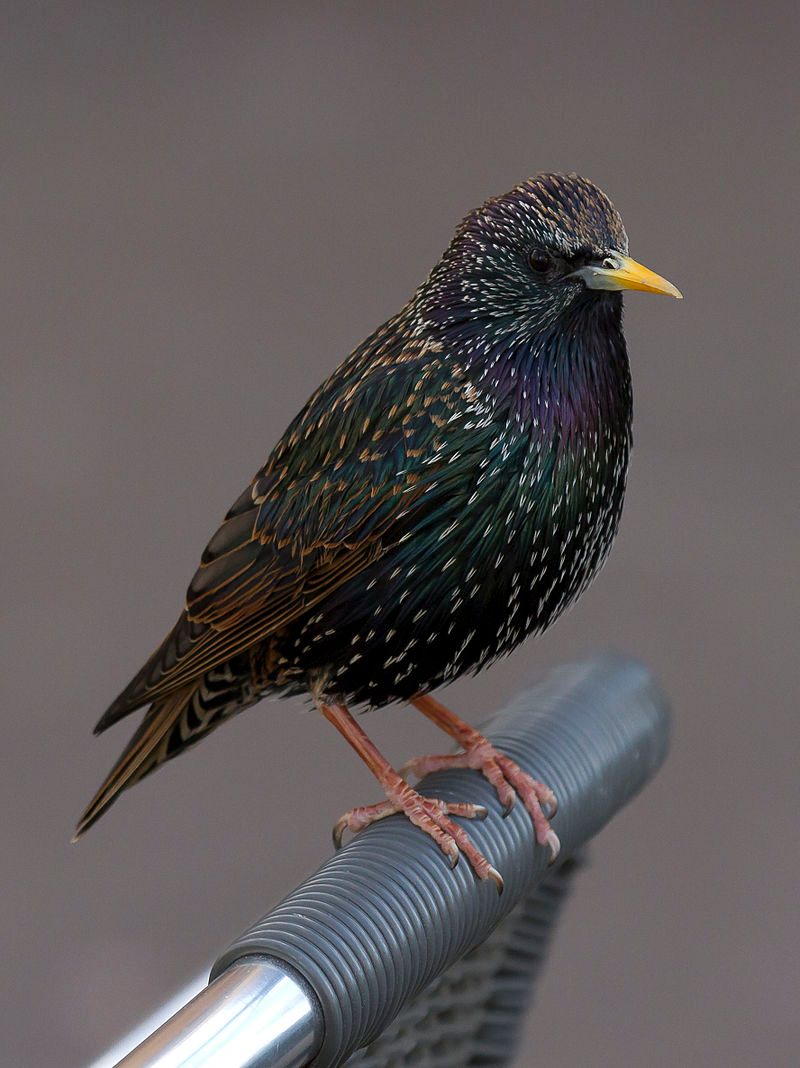
The common starling is a type of bird that can be found in various regions. Depending on the location, it is referred to by different names. It is known as the European starling in North America, while it is called the starling in Great Britain and Ireland.
This bird belongs to the starling family, scientifically known as Sturnidae. The common starling is classified as a passerine bird with a medium-sized build.
Passerine birds are characterized by having feet adapted for perching, and they make up the largest order of birds.
The starling family, to which the common starling belongs, is known for its diverse species worldwide. The common starling is known for its unique features and behaviours.
It has a sleek and shiny black plumage with speckled spots, which gives it a distinct appearance.
The bird’s feathers can also appear iridescent in certain lighting conditions, showcasing shades of green and purple. One of the remarkable aspects of the common starling is its ability to mimic sounds and voices.
It has a wide range of vocalizations and can imitate various sounds it hears in its environment, including other bird calls, human speech, and even mechanical noises.
| Kingdom | Animalia |
| Phylum | Chordata |
| Clade | Dinosauria |
| Class | Aves |
| Order | Passeriformes |
| Family | Sturnidae |
| Genus | Sturnus |
| Species | S. vulgaris |
26. Canada Goose
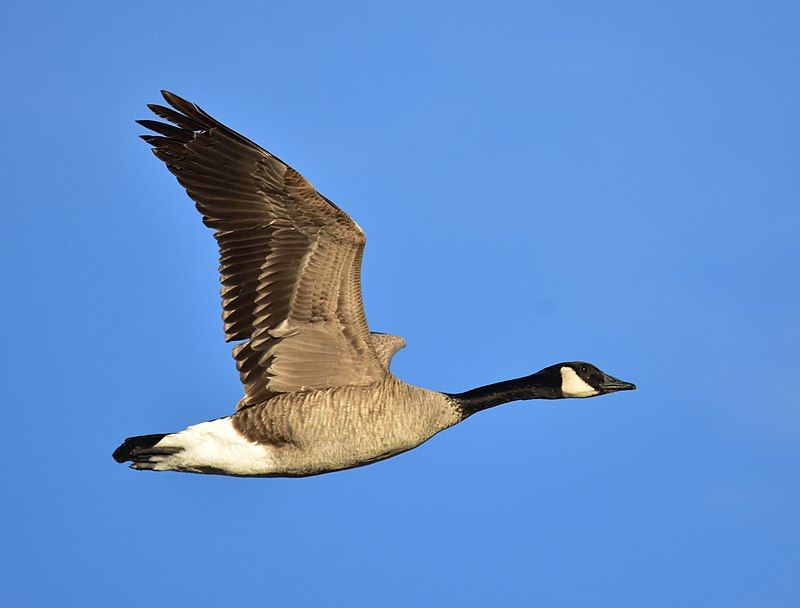
The Canada goose is a type of wild goose that can also be called the Canadian goose. It is quite large in size and has distinct physical features. One of its notable characteristics is a black head and neck.
Additionally, it has white cheeks and a white area under its chin. The body of the Canada goose is typically brown in colour. This goose species is originally from North America’s arctic and temperate regions. It is well-adapted to these colder climates.
However, during migration, the Canada goose has been known to travel across the Atlantic and can occasionally be found in northern Europe. The Canada goose is a fascinating bird that has captured the attention of many due to its unique appearance.
Its black head and neck contrast sharply against its white cheeks and chin.
This distinctive coloration helps to identify the Canada goose from other species easily. Native to North America’s arctic and temperate regions, the Canada goose has evolved to survive in harsh environments.
Its adaptations to cold climates include a sturdy build and insulating feathers.
These features enable the goose to endure freezing temperatures and harsh weather conditions. Although primarily found in North America, the Canada goose displays an interesting behaviour during migration.
| Kingdom | Animalia |
| Phylum | Chordata |
| Clade | Dinosauria |
| Class | Aves |
| Order | Anseriformes |
| Family | Anatidae |
| Genus | Branta |
| Species | B. canadensis |
27. Mallard
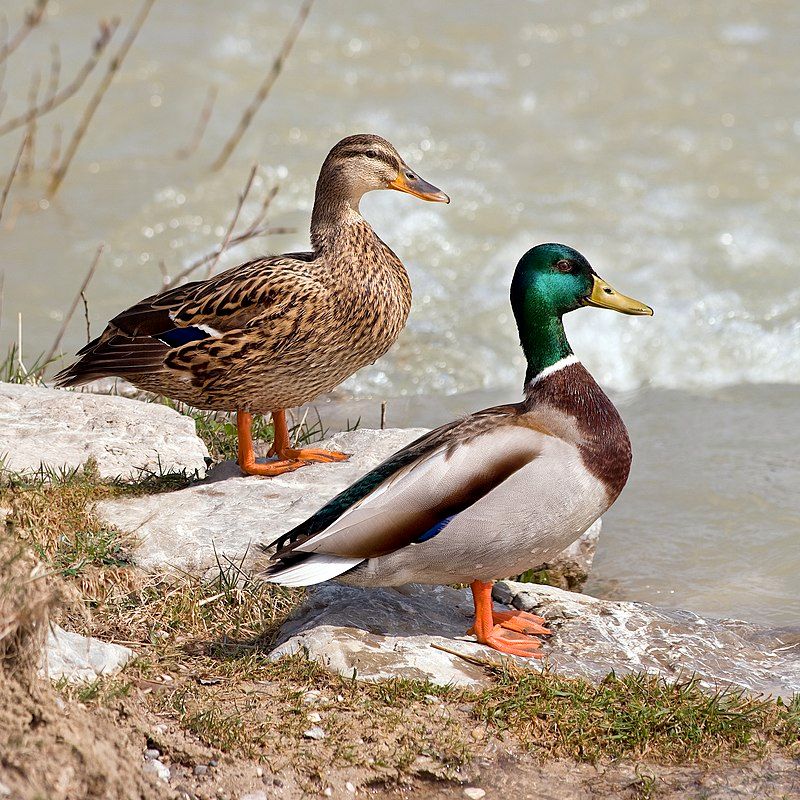
The mallard, also known as the wild duck, is a dabbling duck. It can be found breeding in various world regions, including the temperate and subtropical Americas, Eurasia, and North Africa.
This duck species has been introduced to several countries outside its native range. For example, mallards have been brought to New Zealand, Australia, Peru, Brazil, Uruguay, Argentina, Chile, Colombia, the Falkland Islands, and South Africa.
The mallard’s ability to adapt to different environments has allowed it to thrive in these introduced regions. It is a versatile bird that can adapt to various habitats, such as wetlands, ponds, lakes, and even urban areas. In its native range, the mallard is a migratory bird.
However, in some introduced areas, it has become resident, meaning it stays in one place throughout the year rather than undertaking long-distance migrations.
The mallard is known for its vibrant plumage, with males having a distinctive green head, yellow bill, and brownish body. Conversely, females have a mottled brown appearance, which helps them camouflage with their surroundings.
| Kingdom | Animalia |
| Phylum | Chordata |
| Clade | Dinosauria |
| Class | Aves |
| Order | Anseriformes |
| Family | Anatidae |
| Genus | Anas |
| Species | A. platyrhynchos |
28. Bufflehead

The paragraph discusses the bufflehead, which is a type of small sea duck belonging to the genus Bucephala. This genus also includes other ducks known as goldeneyes.
The bufflehead was first identified and described by Carl Linnaeus, a renowned Swedish scientist, in his influential work called Systema Naturae. Linnaeus published the 10th edition of this book in 1758, where he classified various species of plants and animals.
In this edition, he named the bufflehead Anas albeola, which is the scientific name for this species.
| Kingdom | Animalia |
| Phylum | Chordata |
| Clade | Dinosauria |
| Class | Aves |
| Order | Anseriformes |
| Family | Anatidae |
| Genus | Bucephala |
| Species | B. albeola |
29. Red-Tailed Hawk
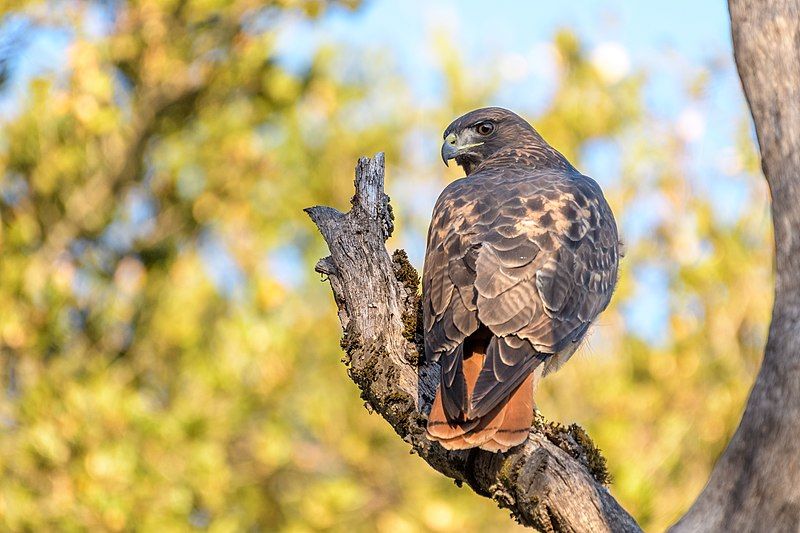
The red-tailed hawk is a type of bird known as a bird of prey. It is found in many different parts of North America. It breeds in a wide range of locations, from the interior of Alaska and northern Canada all the way down to Panama and the West Indies.
This means you can find red-tailed hawks in many places throughout North America. The red-tailed hawk belongs to a group of birds called the genus Buteo. This genus includes many different species of hawks.
However, the red-tailed hawk is one of the most common members of this group, both in North America and worldwide.
This means that you will likely come across a red-tailed hawk more often than other types of hawks within the Buteo genus. The red-tailed hawk is known for its distinctive red tail, which is where it gets its name from.
This feature helps to distinguish it from other types of hawks. However, it is important to note that not all red-tailed hawks have red tails.
Juvenile red-tailed hawks have brown tails, which only turn red as they mature. Red-tailed hawks are known for their impressive hunting skills.
| Kingdom | Animalia |
| Phylum | Chordata |
| Clade | Dinosauria |
| Class | Aves |
| Order | Accipitriformes |
| Family | Accipitridae |
| Genus | Buteo |
| Species | B. jamaicensis |
30. Turkey Vulture

The turkey vulture is a type of vulture that can be found in many different parts of the Americas. It is actually the most widespread of all the New World vultures. There are three species of vultures in a group called the genus Cathartes.
The turkey vulture is one of these species. It belongs to the family Cathartidae, a bird group that includes vultures. The turkey vulture can be found in a vast range of locations.
It can be seen from southern Canada all the way down to the very tip of South America. This means that it can be found in many different countries and environments throughout the Americas. This bird has a very large range because it is well adapted to various habitats.
It is able to thrive in a wide range of conditions and climates. The turkey vulture is known for its characteristic appearance. It has a bald head, which is red in color. Its body is mostly black or dark brown, and it has long wings and a long tail.
This vulture is a scavenger, meaning it feeds on dead animals. It has a highly developed sense of smell, which allows it to locate carrion from high.
| Kingdom | Animalia |
| Phylum | Chordata |
| Clade | Dinosauria |
| Class | Aves |
| Order | Accipitriformes |
| Family | Cathartidae |
| Genus | Cathartes |
| Species | C. aura |
31. European Herring Gull
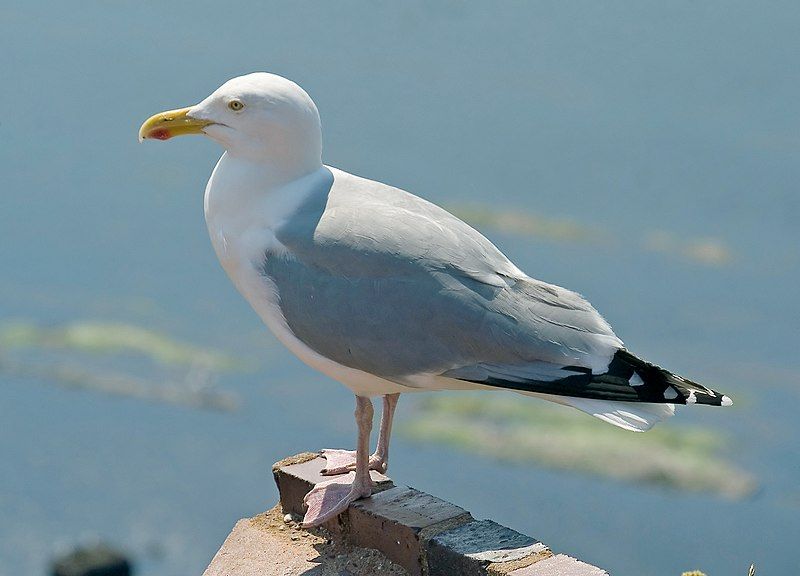
The European herring gull is a type of large gull that can grow up to 66 cm in length. It is commonly found in coastal areas of Western Europe. In the past, this gull species used to be more plentiful in numbers.
The European herring gull is known for its breeding habits across various regions of Europe. It can be found breeding in Northern Europe, Western Europe, Central Europe, Eastern Europe, Scandinavia, and the Baltic states.
This means that the gull’s breeding range is quite extensive and covers a significant part of the continent. Coastal regions are the preferred habitat for the European herring gull.
It is well adapted to living near the sea and can often be spotted near shorelines, beaches, and cliffs. These areas provide the gulls with access to their primary food source: fish.
The European herring gull is a large bird with certain physical characteristics that distinguish it from other gull species. Its size sets it apart, as it is one of the larger gull species found in Europe.
This makes it easier to identify and differentiate from smaller gulls. The European herring gull’s diet mainly consists of fish.
| Kingdom | Animalia |
| Phylum | Chordata |
| Clade | Dinosauria |
| Class | Aves |
| Order | Charadriiformes |
| Family | Laridae |
| Genus | Larus |
| Species | L. argentatus |
32. Ring-Billed Gull
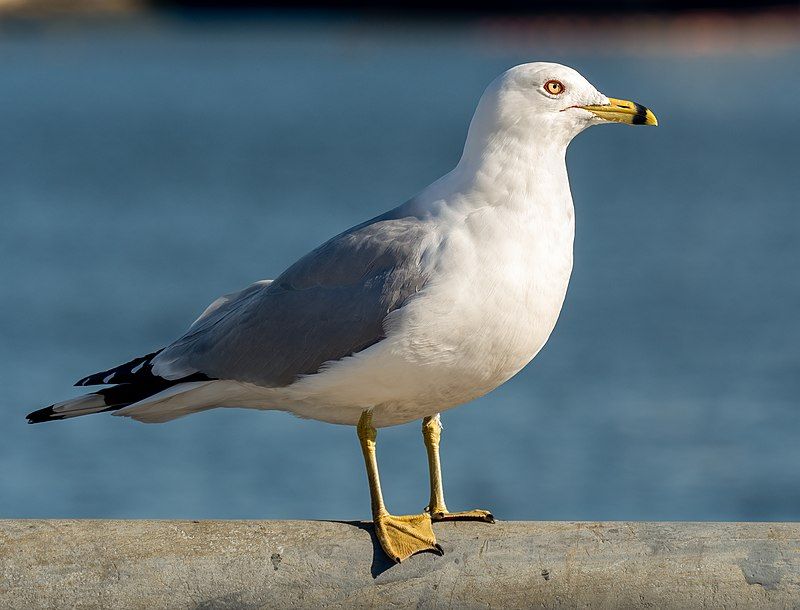
The ring-billed gull is a medium-sized gull. The term “ring-billed” comes from the distinctive ring-like band around its beak. This gull belongs to a group of birds known as Larus, which is the genus name.
The term “Larus” is derived from Latin and seems to have been used to describe gulls or other large seabirds. The genus name Larus is a way to categorize and classify different species of gulls.
It helps scientists and bird enthusiasts understand the relationships and similarities between these birds.
By using the genus name Larus, it becomes easier to identify and study gulls in a systematic manner. The specific name of this particular gull, delawarensis, refers to the Delaware River.
This means the ring-billed gull is associated with or found near the Delaware River.
It is named after this specific location, which may be a significant habitat for this species. The naming of species often involves using specific names that indicate a particular geographic location or characteristic of the species.
In the case of the ring-billed gull, the term delawarensis is used to highlight its connection to the Delaware River.
| Kingdom | Animalia |
| Phylum | Chordata |
| Clade | Dinosauria |
| Class | Aves |
| Order | Charadriiformes |
| Family | Laridae |
| Genus | Larus |
| Species | L. delawarensis |
33. Great Black-Backed Gull

The great black-backed gull is a species of gull that belongs to the largest member of the gull family.
It is known for its impressive size and has been described by the Cornell Lab of Ornithology as “the king of the Atlantic waterfront.”
This suggests that it is dominant among other birds in its habitat. One notable characteristic of the great black-backed gull is its aggressive hunting behaviour.
It is a skilled and determined predator that actively seeks out its prey. This bird does not hesitate to confront other animals or even steal food from them.
It can be considered a formidable and effective hunter. In addition to hunting, the great black-backed gull is also referred to as a “pirate.” This term describes its behaviour of stealing food from other birds or animals.
It does not hesitate to snatch away a meal, even if it means taking it from a weaker or smaller species. This opportunistic behaviour helps the gull in securing its own sustenance. Furthermore, the great black-backed gull is a proficient scavenger.
It has developed a knack for finding and consuming carrion or discarded food. This adaptive behaviour allows the gull to survive in various environments and utilise available food sources.
| Kingdom | Animalia |
| Phylum | Chordata |
| Clade | Dinosauria |
| Class | Aves |
| Order | Charadriiformes |
| Family | Laridae |
| Genus | Larus |
| Species | L. marinus |
34. Northern Mockingbird
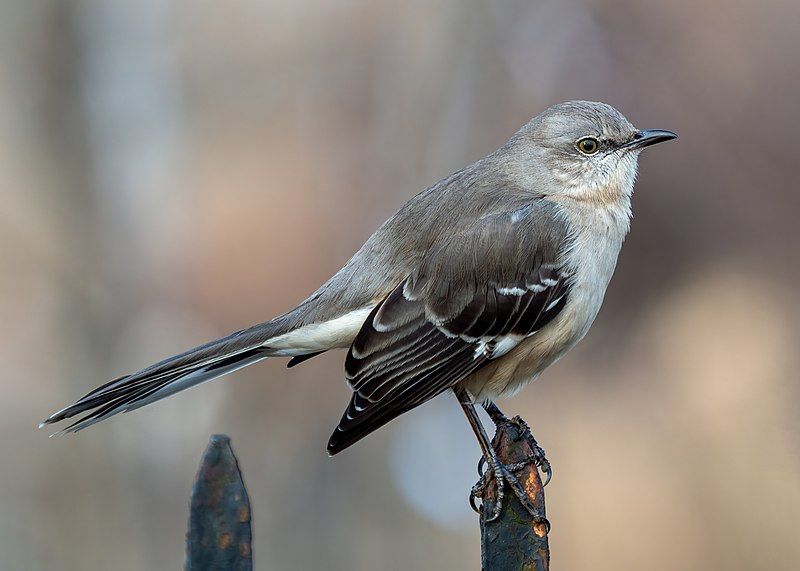
The northern mockingbird is a type of bird that is commonly found in North America. It is known for its ability to mimic the songs of other birds and even sounds from its environment.
This bird is typically seen throughout the year in North America, as it is a permanent resident in the region.
However, during periods of extreme weather, such as harsh winters, some northern mockingbirds may decide to migrate south in search of more favourable conditions.
This migration is not common and only occurs when the weather becomes too challenging for these birds to handle. Despite being primarily found in North America, the northern mockingbird has been occasionally observed in Europe.
However, such sightings are quite rare, and this species is not considered a regular visitor to the European continent. It is interesting to note the adaptability of the northern mockingbird in terms of its ability to survive in different environments.
While it is mainly found in North America, it has the capacity to move to more suitable locations during times of adversity. The northern mockingbird’s ability to mimic sounds is a unique characteristic that sets it apart from other bird species.
This skill allows it to imitate the songs of various birds and sounds like car alarms, sirens, or even human speech.
| Kingdom | Animalia |
| Phylum | Chordata |
| Clade | Dinosauria |
| Class | Aves |
| Order | Passeriformes |
| Family | Mimidae |
| Genus | Mimus |
| Species | M. polyglottos |
35. Indigo Bunting

The indigo bunting is a type of bird that belongs to the cardinal family. It is known for its small size and its diet mainly consisting of seeds. This bird is migratory, meaning it travels from one place to another depending on the season.
It can be found in southern Canada up to northern Florida during the breeding season. However, during the winter, it moves to southern Florida and even as far as northern South America. Interestingly, the indigo bunting has a unique way of migrating.
It prefers to travel at night, using the stars as a guide to navigate. This ability to use celestial cues demonstrates the bird’s remarkable sense of direction.
It can accurately find its way to its desired destination by relying on the stars. Migrating at night provides certain advantages for the indigo bunting.
Firstly, the cooler temperatures at night make it more comfortable for the bird to travel long distances.
Additionally, flying during the night reduces the risk of predation, as many predators are less active during those hours.
This allows the indigo bunting to avoid potential dangers and increases its chances of survival during its journey. The indigo bunting’s reliance on the stars also showcases its ability to perceive and interpret celestial patterns.
| Kingdom | Animalia |
| Phylum | Chordata |
| Clade | Dinosauria |
| Class | Aves |
| Order | Passeriformes |
| Family | Cardinalidae |
| Genus | Passerina |
| Species | P. cyanea |
36. Carolina Chickadee
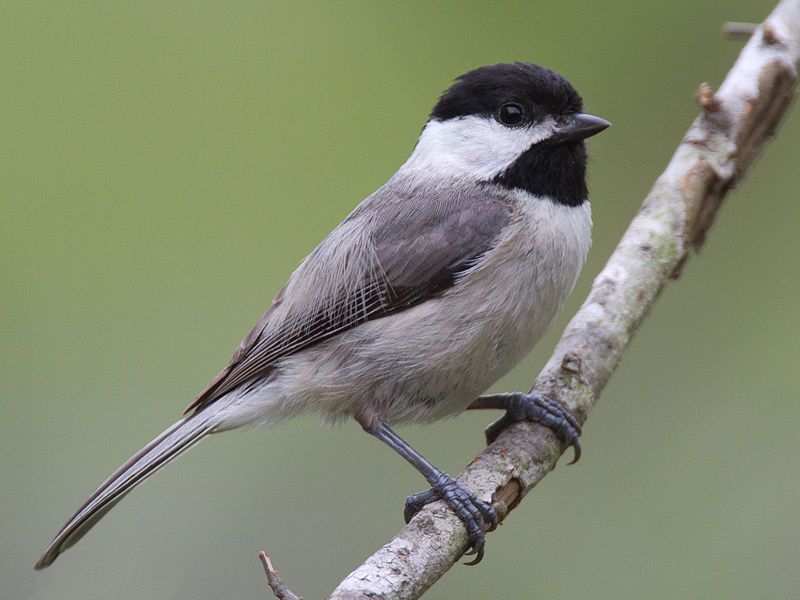
The Carolina chickadee is a type of bird that belongs to the passerine bird family known as Paridae. It is a small bird that is often seen in North America.
The passerine bird family includes other birds like tits, which are known for their small size and agile nature. Carolina chickadees are known for their distinct appearance and behaviour. They have a round body shape, short necks, and small beaks.
Their feathers are mostly grey on the upper parts and white on the under parts, with black and white markings on their wings and tails.
This coloration helps them blend in with their surroundings and provides camouflage for protection. These birds are often found in deciduous and mixed forests and residential areas with trees and shrubs.
They prefer habitats with a variety of vegetation, including both coniferous and deciduous trees.
They are also known to visit bird feeders in people’s yards, especially during winter, when food is scarce. Carolina chickadees are social birds and are often seen in small flocks.
They communicate with each other through a variety of vocalizations, including their well-known “chick-a-dee-dee-dee” call.
| Kingdom | Animalia |
| Phylum | Chordata |
| Clade | Dinosauria |
| Class | Aves |
| Order | Passeriformes |
| Family | Paridae |
| Genus | Poecile |
| Species | P. carolinensis |
37. Barn Swallow
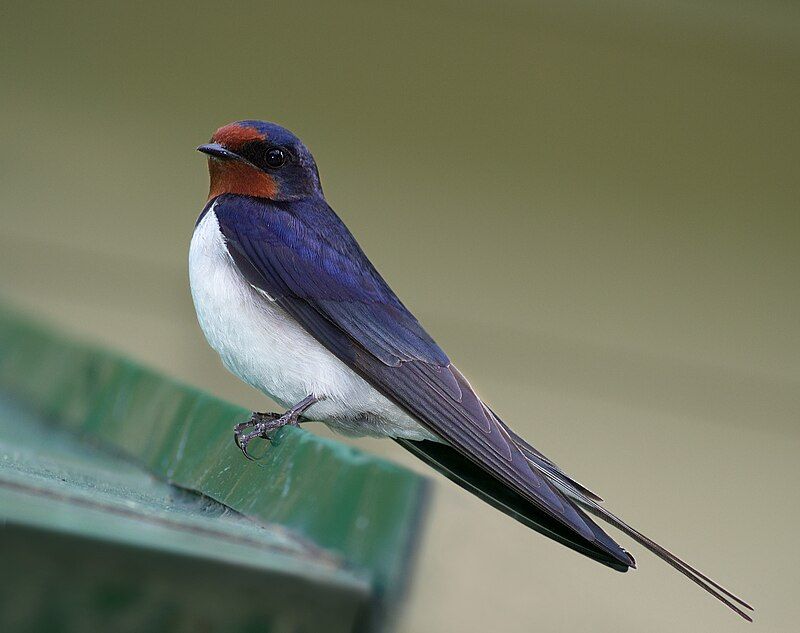
The barn swallow is a type of bird that can be found worldwide. It is actually the most common species of swallow.
This means that there are more barn swallows than any other type of swallow in the world. What is interesting about the barn swallow is that it can be found in many different places. It has the largest natural distribution of any passerine bird.
Passerine birds are a type of bird that includes sparrows, finches, and swallows. This means that the barn swallow can be found in more areas than any other type of passerine bird. In fact, the barn swallow’s range covers over 251 million square kilometres worldwide.
That is a huge area! To put it into perspective, that’s about the same size as the entire continent of Europe.
So, no matter where you go in the world, there is a good chance that you will spot a barn swallow. The barn swallow is easily recognizable due to its distinctive appearance. It has blue upper parts, which means that its back and wings are blue in colour.
This blue colour is quite vibrant and stands out against the sky. It also has a long, deeply forked tail. This means that its tail is split into two distinct points.
| Kingdom | Animalia |
| Phylum | Chordata |
| Clade | Dinosauria |
| Class | Aves |
| Order | Passeriformes |
| Family | Hirundinidae |
| Genus | Hirundo |
| Species | H. rustica |
38. Red-Winged Blackbird
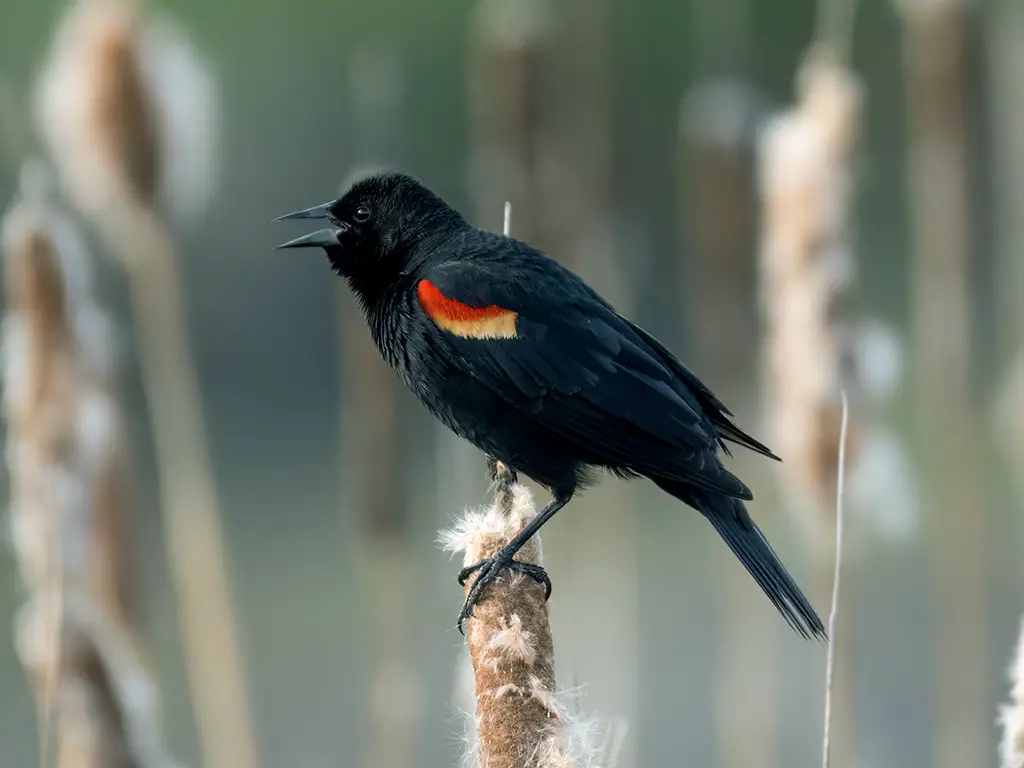
The red-winged blackbird is a type of bird that belongs to the passerine family called Icteridae.
It is commonly found in various parts of North America and a significant portion of Central America. Passerines are a diverse group of birds that are known for their musical and complex songs.
They have specialized vocal organs that allow them to produce a wide range of sounds. The red-winged blackbird is easily recognizable due to its distinct appearance.
The male red-winged blackbird has glossy black plumage and bright red patches on its wings, which give it its name.
On the other hand, the female red-winged blackbird has a more subdued appearance with brown feathers and streaks. These birds have a unique habitat preference, as they are commonly found in wetlands, marshes, and areas with tall grasses.
They are skilled at perching on tall plants and reeds, where they can easily spot their prey and potential predators. Red-winged blackbirds primarily feed on insects, seeds, and grains. They use their sharp beaks to catch insects on the fly and extract seeds from plants.
During the breeding season, they may also consume small vertebrates such as frogs and tadpoles.
| Kingdom | Animalia |
| Phylum | Chordata |
| Clade | Dinosauria |
| Class | Aves |
| Order | Passeriformes |
| Family | Icteridae |
| Genus | Agelaius |
| Species | A. phoeniceus |
39. Ruby-Throated Hummingbird
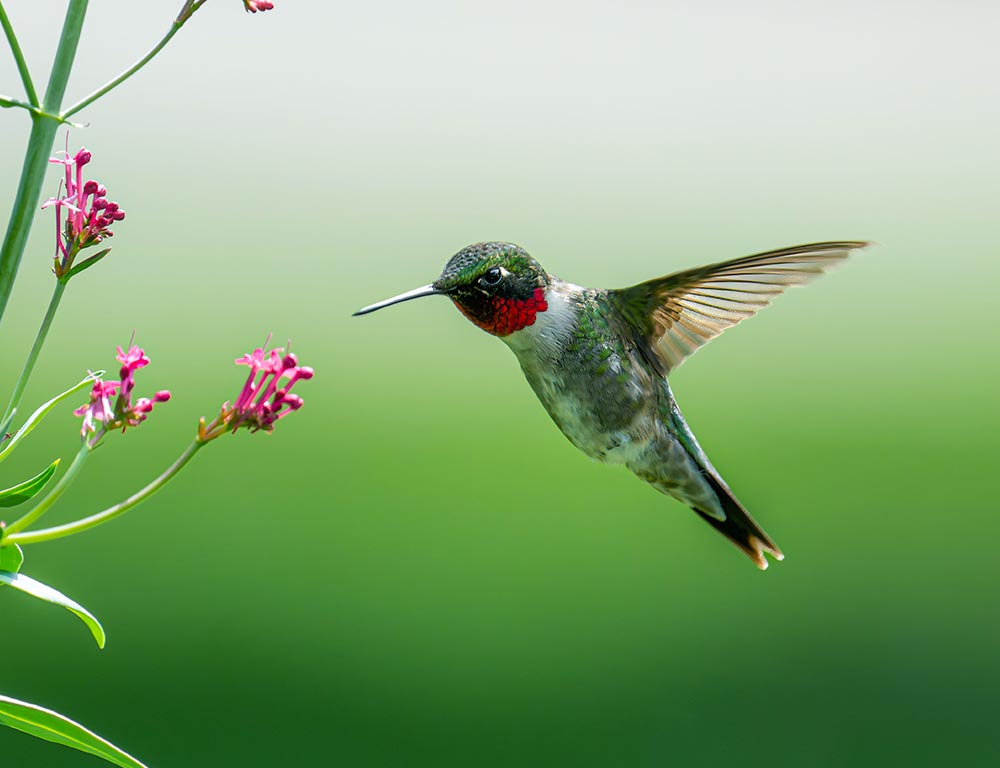
The ruby-throated hummingbird is a type of hummingbird that has a bright red throat. This species is known for its unique migration pattern. These hummingbirds can be found in Central America, Mexico, and Florida during the winter months.
They choose these warmer regions because they provide a more suitable climate for their survival. However, the ruby-throated hummingbird embarks on an incredible journey when the summer season arrives.
They migrate all the way to Canada and other parts of Eastern North America to breed.
This long-distance migration allows them to take advantage of the abundant resources available in these areas during the summer months. The reason behind this seasonal migration is quite fascinating.
In Central America, Mexico, and Florida, the ruby-throated hummingbirds find a variety of nectar-producing flowers that provide them with a sufficient food source.
These flowers bloom during the winter, ensuring the hummingbirds have enough energy to survive. But as the seasons shift and the temperatures rise, the flowers in these regions begin to wither away.
This scarcity of food prompts the hummingbirds to undertake their impressive journey northward. They instinctively know that Canada and Eastern North America offer abundant nectar-producing flowers during the summer, which is ideal for them.
| Kingdom | Animalia |
| Phylum | Chordata |
| Clade | Strisores |
| Class | Aves |
| Order | Apodiformes |
| Family | Trochilidae |
| Genus | Archilochus |
| Species | A. colubris |
40. Yellow-Rumped Warbler
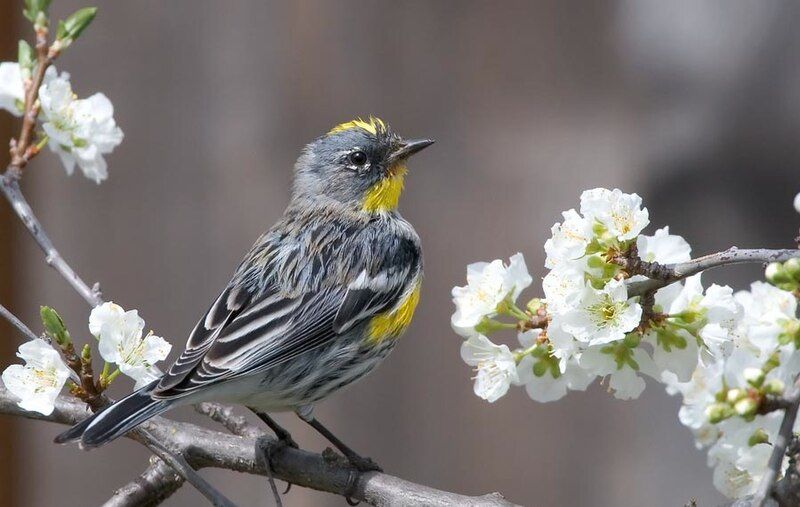
The yellow-rumped warbler is a type of bird that is found in North America. It is quite common and can be seen in many different places across the continent. This bird species is known for its distinct yellow feathers on its rump or lower back.
This is where it gets its name from. These yellow feathers make it easy to identify the yellow-rumped warbler in the wild.
The yellow-rumped warbler is a small bird, measuring around 5 to 6 inches in length. It has a slim body with a pointed beak and long wings.
Its wingspan can reach up to 9 to 10 inches, allowing it to fly swiftly and gracefully. One interesting fact about this bird is that it is known for its ability to migrate long distances. Yellow-rumped warblers can be found in North America during the breeding season.
However, they migrate south to warmer regions, such as Mexico and Central America, when winter arrives. This bird species can be found in a variety of habitats. It is often seen in forests, woodlands, and even urban areas.
It has adapted well to different environments and can thrive in both deciduous and coniferous forests. The yellow-rumped warbler has a diverse.
| Kingdom | Animalia |
| Phylum | Chordata |
| Clade | Dinosauria |
| Class | Aves |
| Order | Passeriformes |
| Family | Parulidae |
| Genus | Setophaga |
| Species | S. coronata |
41. Evening Grosbeak
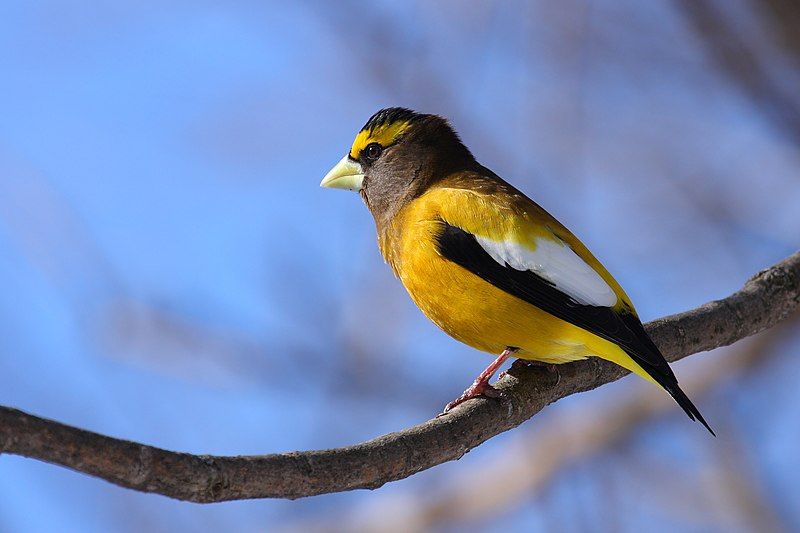
The evening grosbeak is a type of bird from the finch family found in North America. It is known for its bulky body, large bill, and short tail. Scientists have classified it under the genus Hesperiphona.
| Kingdom | Animalia |
| Phylum | Chordata |
| Clade | Dinosauria |
| Class | Aves |
| Order | Passeriformes |
| Family | Fringillidae |
| Genus | Hesperiphona |
| Species | H. vespertina |
42. Pileated Woodpecker
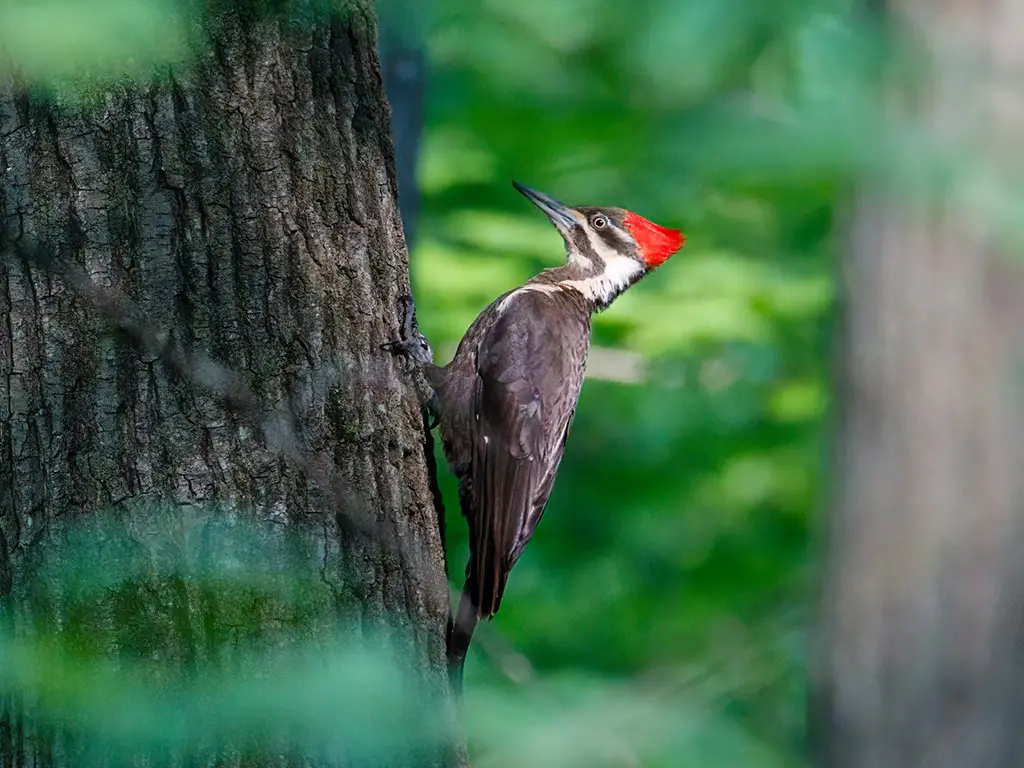
The pileated woodpecker is a type of bird that is mostly black and is found in North America. It is a relatively large bird compared to other woodpeckers. The pileated woodpecker mostly eats insects, which makes it an insectivore.
It usually lives in deciduous forests located in eastern North America. In addition to the eastern part of North America, the pileated woodpecker can also be found in the Great Lakes region. This means it can be seen in areas like Michigan, Minnesota, and the surrounding states.
The bird is also found in the boreal forests of Canada. These forests are characterized by mostly coniferous trees and are located in northern Canada. Furthermore, the pileated woodpecker can be spotted in certain areas along the Pacific Coast.
This means it can be found in states like Oregon and Washington. It is interesting to note that the bird’s habitat spans across different regions, showing its adaptability to various environments.
Overall, the pileated woodpecker is a fascinating bird that is native to North America. Its black feathers and relatively large size make it easy to identify. It prefers to live in deciduous forests.
| Kingdom | Animalia |
| Phylum | Chordata |
| Clade | Dinosauria |
| Class | Aves |
| Order | Piciformes |
| Family | Picidae |
| Genus | Dryocopus |
| Species | D. pileatus |
43. Brown-Headed Cowbird
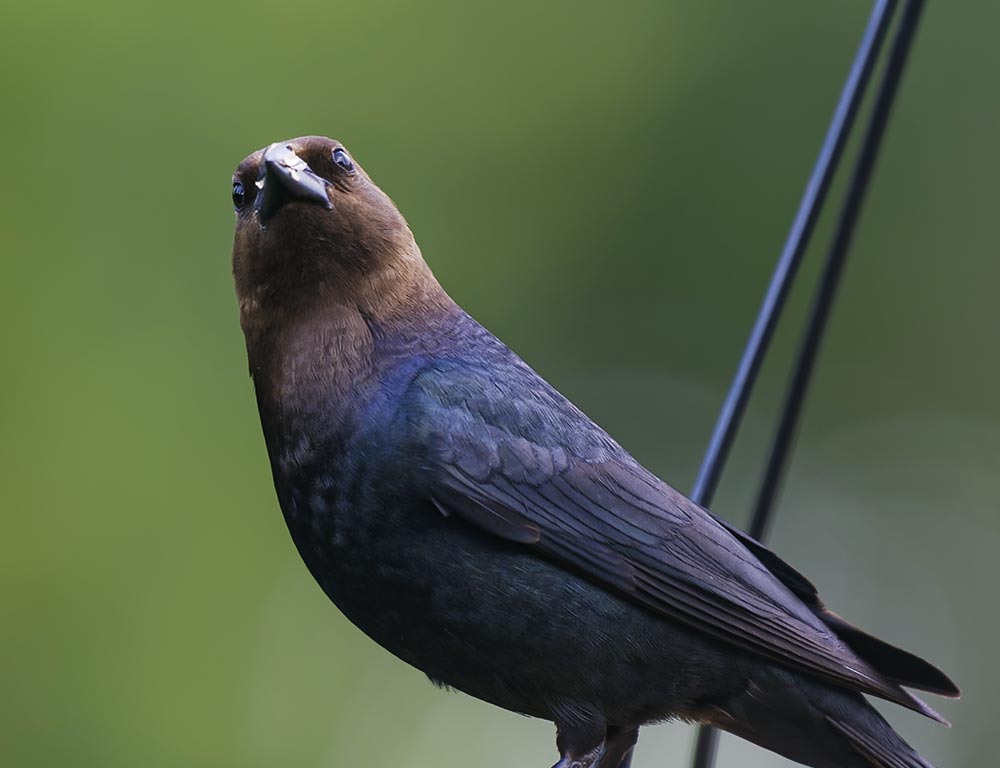
The brown-headed cowbird is a bird species found in temperate and subtropical regions of North America. It is known for its behaviour as a brood parasite, meaning it lays its eggs in the nests of other bird species.
This behaviour is obligatory for the brown-headed cowbird, which means it relies on other birds to raise its young. The brown-headed cowbird is a small bird with a brown head and dark body.
It is commonly found in the southern parts of its range throughout the year, where it remains a permanent resident.
However, the birds from the northern regions migrate to the southern United States and Mexico during the winter season.
The migration of the northern brown-headed cowbirds occurs because the colder conditions in their northern habitats make it challenging to find sufficient food during the winter months.
Travelling to the southern regions, where the climate is milder, and food resources are more abundant, increases their chances of survival. The migration typically takes place in a southward direction, starting around the onset of winter.
These birds undertake a long journey, often flying for many miles to reach their wintering grounds. They remain in these warmer regions until the arrival of spring, which is around March or April. Once the winter season ends.
| Kingdom | Animalia |
| Phylum | Chordata |
| Clade | Dinosauria |
| Class | Aves |
| Order | Passeriformes |
| Family | Icteridae |
| Genus | Molothrus |
| Species | M. ater |
44. Winter Wren
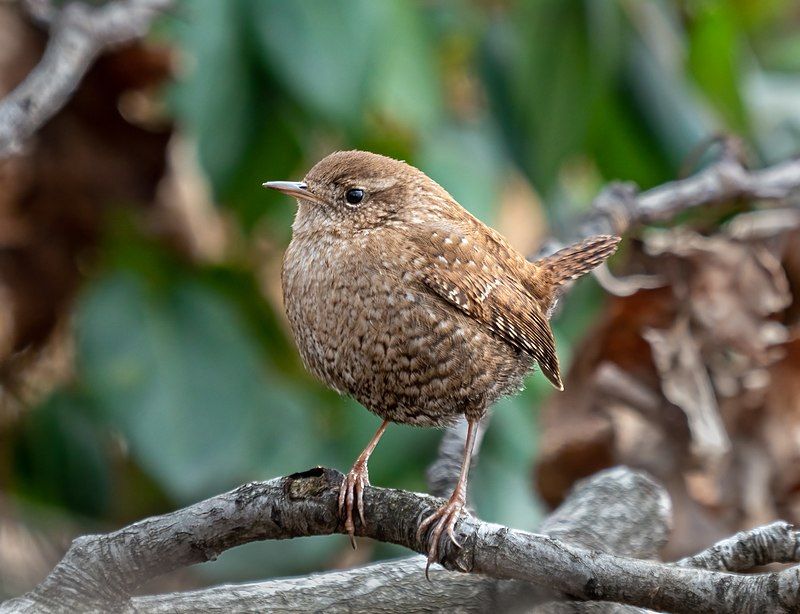
The winter wren is a tiny bird found in North America. It belongs to the Troglodytidae family, mainly consisting of wrens in the New World.
In the past, it was considered the same species as the Pacific wren in western North America and the Eurasian wren in Eurasia.
However, it is now recognized as a distinct species called the winter wren. The winter wren is known for its small size and is one of the smallest birds in North America.
It can be found in coniferous forests, which are forests dominated by cone-bearing trees like pine, spruce, and fir. Its habitat ranges from British Columbia in Canada to the Atlantic Ocean. This little bird is known for its distinctive behaviour and appearance.
It has a compact body with short wings and a short tail, making it well-suited for navigating through dense forest vegetation. Its plumage is usually dark brown with fine streaks on its back and a light-coloured throat and belly.
During the breeding season, which usually occurs in the spring and summer, the winter wren builds its nest in tree cavities or among tree roots. The male wren is known for its beautiful and melodious song.
| Kingdom | Animalia |
| Phylum | Chordata |
| Clade | Dinosauria |
| Class | Aves |
| Order | Passeriformes |
| Family | Troglodytidae |
| Genus | Troglodytes |
| Species | T. hiemalis |
45. Purple Finch

The purple finch is a type of bird. It belongs to the finch family called Fringillidae. This family includes various species of finches. The purple finch is one of them. This bird is found in different parts of North America.
It breeds in the northern United States, laying eggs and raising its young there. It also breeds in southern Canada, which is the region located below the northern part of Canada.
Additionally, the bird can be found along the west coast of North America. Breeding refers to the process of reproduction in animals, where they mate and produce offspring. Like the purple finch, birds build nests and lay eggs for breeding.
They take care of their eggs until they hatch, then raise their chicks until they are ready to leave the nest. The purple finch is known for its vibrant purple colouration.
Males have a deep red or raspberry-coloured plumage with a purple tint, while females have a more subdued plumage with streaks of brown and white.
This difference in appearance between males and females is called sexual dimorphism. In addition to its striking colour, the purple finch has a sturdy beak that is well-suited for cracking open seeds.
| Kingdom | Animalia |
| Phylum | Chordata |
| Clade | Dinosauria |
| Class | Aves |
| Order | Passeriformes |
| Family | Fringillidae |
| Genus | Haemorhous |
| Species | H. purpureus |
46. Red-Headed Woodpecker
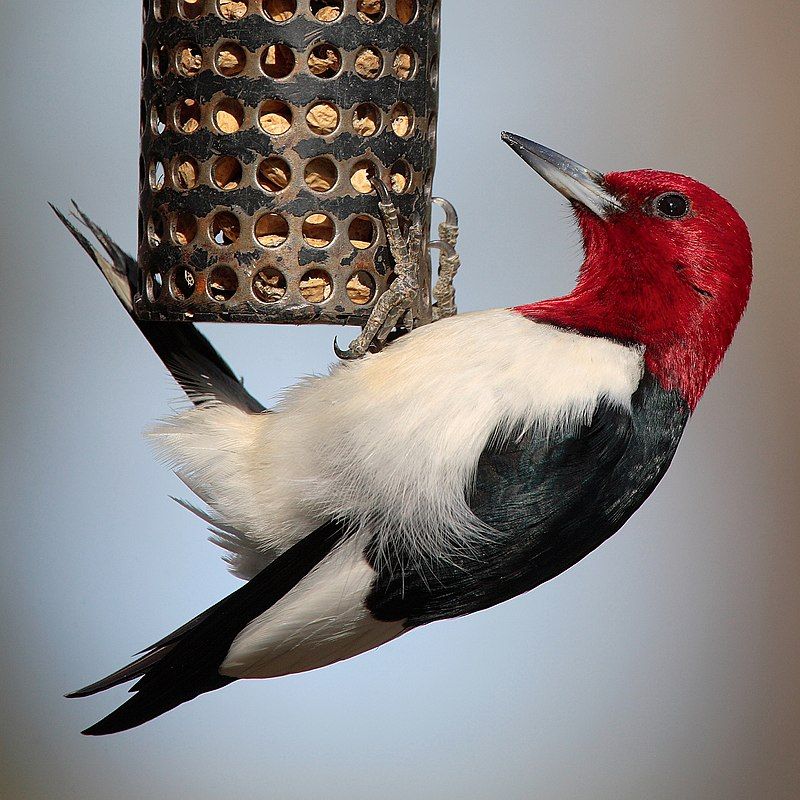
The red-headed woodpecker is a type of woodpecker that can be found in temperate regions of North America. It is not too big or too small, but rather a mid-sized bird. This woodpecker is known for its distinct red head, which sets it apart from other woodpecker species.
Its vibrant red colour stands out against its black and white body. Regarding its habitat, the red-headed woodpecker prefers open areas in southern Canada and the east-central United States. It is specifically found in regions with a moderate climate.
This woodpecker builds its nests during the breeding season in these open country habitats. It looks for suitable spots to create its nest, often choosing dead trees or branches.
The red-headed woodpecker is a skilled excavator, using its strong beak to make holes in the trees for its nests. These holes not only serve as a nesting site but also as a source of food storage.
In addition to nesting, the red-headed woodpecker also searches for food in its breeding habitat. It feeds on various insects, fruits, nuts, and even small vertebrates. This woodpecker is known for its agility and acrobatics.
| Kingdom | Animalia |
| Phylum | Chordata |
| Clade | Dinosauria |
| Class | Aves |
| Order | Piciformes |
| Family | Picidae |
| Genus | Melanerpes |
| Species | M. erythrocephalus |
47. Rufous Hummingbird
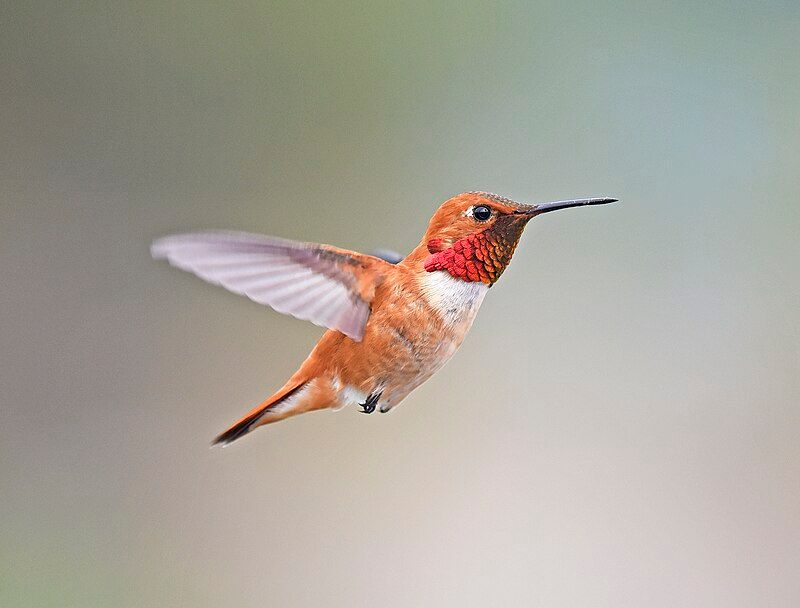
The rufous hummingbird is tiny, measuring only about 8 cm in length. It has a distinctive long, straight, and slender bill, which it uses to feed on flower nectar. These birds are renowned for their exceptional flight abilities.
During their migratory journeys, they can cover an astonishing distance of up to 2,000 miles. The rufous hummingbird belongs to a group called the Selasphorus genus, which comprises a total of nine different species.
Each species within this genus shares similar characteristics and features. However, the rufous hummingbird is unique in its own way. These birds’ flight skills are truly remarkable.
They are capable of hovering in mid-air, flying forward and backwards, and even flying upside down. Their wings beat incredibly fast, allowing them to stay in one place while feeding on nectar.
This agile flight pattern also enables them to catch small insects mid-air, which they supplement their diet with. During their long migratory transits, rufous hummingbirds travel vast distances.
They undertake these journeys in search of suitable breeding grounds and food sources. Despite their small size, these birds possess impressive endurance and determination to reach their destinations.
| Kingdom | Animalia |
| Phylum | Chordata |
| Clade | Strisores |
| Class | Aves |
| Order | Apodiformes |
| Family | Trochilidae |
| Genus | Selasphorus |
| Species | S. rufus |
48. Brant
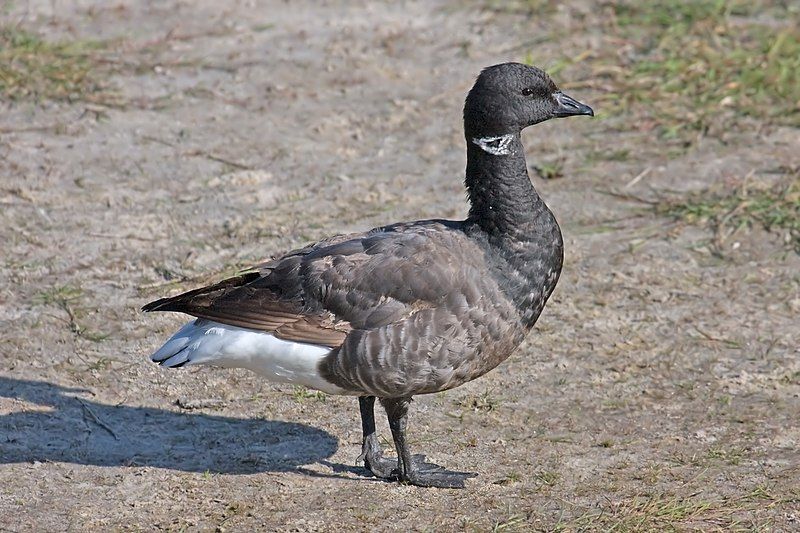
The brant or Brent goose is a small goose that belongs to the genus Branta. This species is known for its winter migration along sea-coasts in temperate-zone areas. During the breeding season, they can be found on the high-Arctic tundra.
Interestingly, the Brent oilfield got its name from this particular goose species. It is important to note that the oilfield is not directly related to the bird but rather named after it.
This naming might be due to the oilfield’s geographical location, which is in the Brent region of the North Sea. The Brent oilfield is a significant offshore oil and gas field that was discovered in the 1970s.
It has been a major source of oil production for several decades. The decision to name it after the Brent goose might have been influenced by the fact that the bird is also commonly found in the North Sea region.
The Brent goose’s habitat preference for coastal areas might have also influenced the naming decision. The oilfield is situated in the North Sea, which is a large body of water bordered by several countries, including the United Kingdom, Norway, Denmark, and Germany.
| Kingdom | Animalia |
| Phylum | Chordata |
| Clade | Dinosauria |
| Class | Aves |
| Order | Anseriformes |
| Family | Anatidae |
| Genus | Branta |
| Species | B. bernicla |
49. Snowy Owl
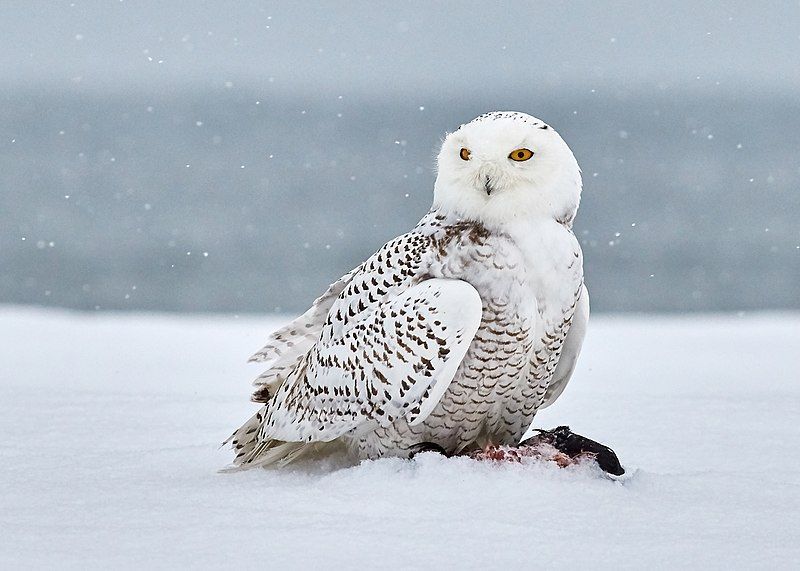
The snowy owl is a type of owl that is also known by other names, such as the polar owl, the white owl, and the Arctic owl. It belongs to the true owl family and is characterized by its large size and white feathers.
These owls can be found in both North America and the Palearctic regions, specifically in the Arctic areas. Snowy owls are well adapted to their harsh Arctic environments.
They have evolved to blend in with the snowy landscapes, which helps them remain camouflaged and hidden from predators.
Their white feathers act as a protective cover, allowing them to hunt and survive in their habitat. One interesting fact about snowy owls is that they are predominantly found in the tundra regions.
The tundra is a cold and treeless biome that is characterized by low temperatures and short summers. This environment provides ideal conditions for the snowy owl’s breeding. During the breeding season, snowy owls build their nests on the ground.
They use the tundra’s vegetation and materials like feathers and moss to construct their nests. This nesting behaviour is unique among owls, as most other owl species prefer to nest in trees. Snowy owls feed primarily on small mammals, such as lemmings and voles.
| Kingdom | Animalia |
| Phylum | Chordata |
| Clade | Dinosauria |
| Class | Aves |
| Order | Strigiformes |
| Family | Strigidae |
| Genus | Bubo |
| Species | B. scandiacus |
Conclusion
Winter birds in New Jersey play a crucial role in maintaining the biodiversity and ecological balance of the region. Their ability to adapt to harsh winter conditions, find food sources, and survive in various habitats showcases their resilience and adaptability.
Birdwatchers and nature enthusiasts can witness the unique and diverse species that migrate or overwinter in New Jersey.
By understanding and protecting these winter birds and their habitats, we can contribute to conservation efforts and ensure their continued presence in the state.